Torah Haven in the New World
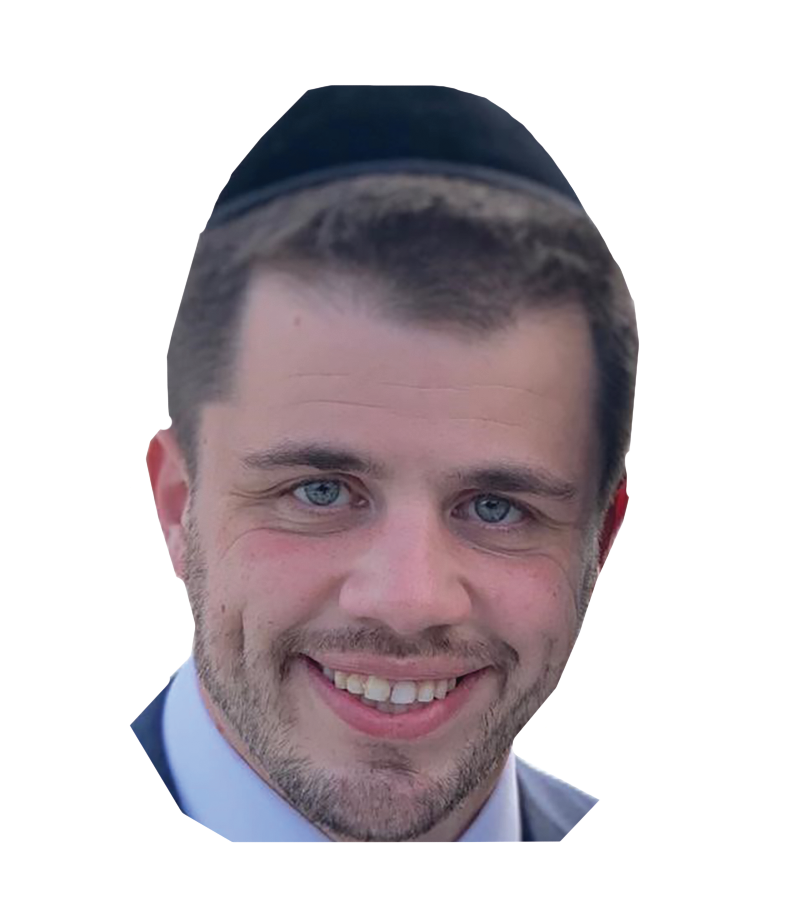
How Rav Yehuda Heschel Levenberg sowed the seeds of advanced Torah study in America
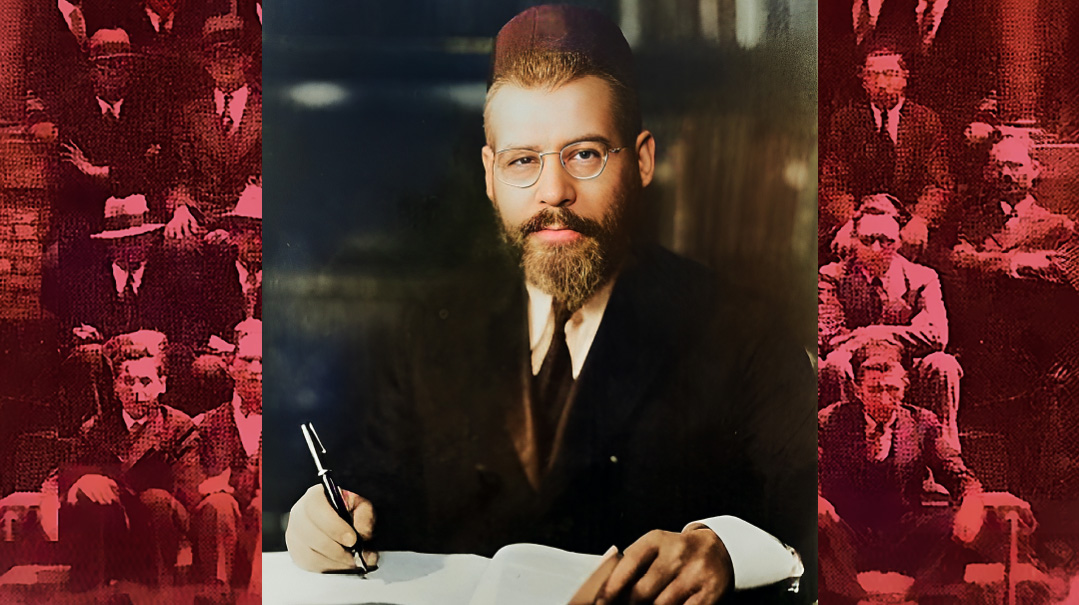
With additional research by Moshe Dembitzer
Photo Credits: YIVO, JDC Archives, Yeshiva University Archives, Machon Avodas Levi, Levenberg Family, Neuberger Family, Feivel Schneider, Pini Dunner, University of Texas-Austin Archives, Gordon Family, Walkin Family, The Jewish Historical Society of Greater New Haven
When Slabodka student Rav Yehuda Heschel Levenberg arrived in prewar America, his vision for a European-style mussar yeshivah was deemed foreign and unrealistic. Yet he marshaled the support and enthusiasm to open a unique institution on American shores, where students pursued the heights of Torah knowledge along with lofty character development.
He managed to lead his New Haven yeshivah for just a short, tumultuous period — but it left an outsized footprint on the postwar Torah world to come. Like the biblical Yehudah, Rav Yudel Levenberg traveled to a new, strange land ahead of his brothers, to build a yeshivah for the future arrivals. His yeshivah is no longer, but he will forever be counted as a founding father of America’s Torah world.
The summer of 1937 was a turning point for two young Montreal-bred yeshivah bochurim, Nosson Wachtfogel (1910-1998) and Shmuel Schechter (1915-2000). After several years of learning at the Mir Yeshivah in Poland, they had returned home at the behest of their parents, following the passing of the illustrious Rav Yerucham Levovitz (1875-1936). They had agreed that this respite would be a short one — soon they would return to Europe, to the great citadel of mussar in Kelm.
But soon after they arrived back in North America, an opportunity arose for the budding Torah leaders: to attend to the ailing Rav Yehuda Heschel Levenberg, a prime Slabodka talmid and the pride of the Alter himself. Rav Levenberg’s once-robust frame, now ravaged by a relentless onslaught of illness, bore the scars of a life dedicated to the tireless pursuit of Torah and mussar. A stroke had left him partially paralyzed, but his indomitable spirit remained unbroken.
Rav Nosson and Rav Shmuel did not hesitate. They recognized the magnitude of the zechus before them — to attend to a true gadol b’Yisrael, the leading baal mussar in America, who had devoted every fiber of his being to plant the seeds of Torah in the challenging soil of the goldeneh medineh.
And so, when July arrived, they found themselves at Kleinberg’s Hotel in Woodridge, New York, where Rav Levenberg’s talmidim had arranged for him to spend the summer months. The days were long and the work was arduous, but the two young men relished every moment spent in the presence of greatness. They witnessed firsthand the depths of Rav Levenberg’s mesirus nefesh and the sheer force of will that had propelled him to build Torah in America against all odds.
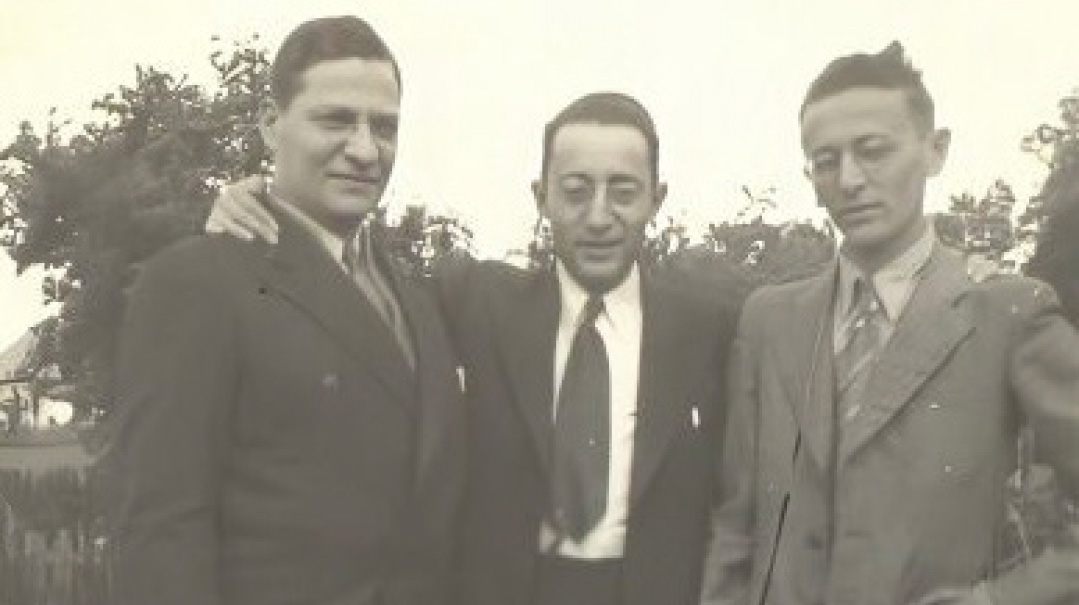
A trio in Kelm: (L-R) Rav Shmuel Schechter (future Beth Medrash Govoha mashgiach), Rav Nosson Wachtfogel, and their close friend Reb Aryeh Stamm Hy”d
As Elul approached, a spark of an idea took hold. They reached out to their friend Rabbi Alexander (Sender) Linchner (1908-1997), an early talmid of Rav Levenberg in New Haven, whose father-in-law, Rav Shraga Feivel Mendlowitz (1886-1948), had just opened Camp Mesivta in nearby Ferndale. Reb Shraga Feivel, who shared a deep bond of respect and common purpose with Rav Levenberg, immediately agreed to host the gadol for a shmuess on the eve of Rosh Chodesh Elul.
The arrival of Rav Levenberg at Camp Mesivta was a scene etched in emotion. The campers, resplendent in their Shabbos finery, sang and danced with unbridled joy. Their rosh yeshivah, the venerated Rav Shlomo Heiman — himself no stranger to the trials of ill health — stood at the camp’s entrance awaiting the arrival of his fellow general in the battle to build Torah in America.
As Rav Levenberg was wheeled into the dining room, a hush fell over the assembled crowd. The silence was so profound that the chirping of birds outside seemed to echo like thunder. And then, the gadol began to speak. Every word was an effort, every breath a labor of love. His voice, once a clarion call that had stirred the hearts of thousands, now faltered and slurred. But the fire in his eyes never dimmed. It was a testament to the indomitable spirit of a man who had given everything — his health, his strength, his very life — to ensure that the flame of Torah would burn bright on American shores.
Just a few months later, Rav Yehuda Heschel Levenberg was niftar, his earthly mission complete. As Rav Shmuel Schechter painted the scene five decades later, he put it quite simply. “He died al kiddush Hashem — for the sake of Heaven.”
But long before the final chapter of his life, he lived al kiddush Hashem — devoting every ounce of his strength and considerable talent to the yeshivos he built, the talmidim he inspired, and the countless lives he touched with his boundless devotion to Hashem and His people.
What sort of chief rabbi circles his city, begging for leftover tomatoes for the yeshivah bochurim in his care? What sort of elite yeshivah student forgoes a promised dowry so as not to pain a hopeful bride? What sort of rav faces arrest and imprisonment because of his refusal to compromise on kashrus?
Rav Levenberg was that sort of leader. He fused the highest standards of Torah learning with the highest standards of mussar, and built a European-style yeshivah in America a century ago, showing young American boys that they, too, could reach the heights of Torah greatness.
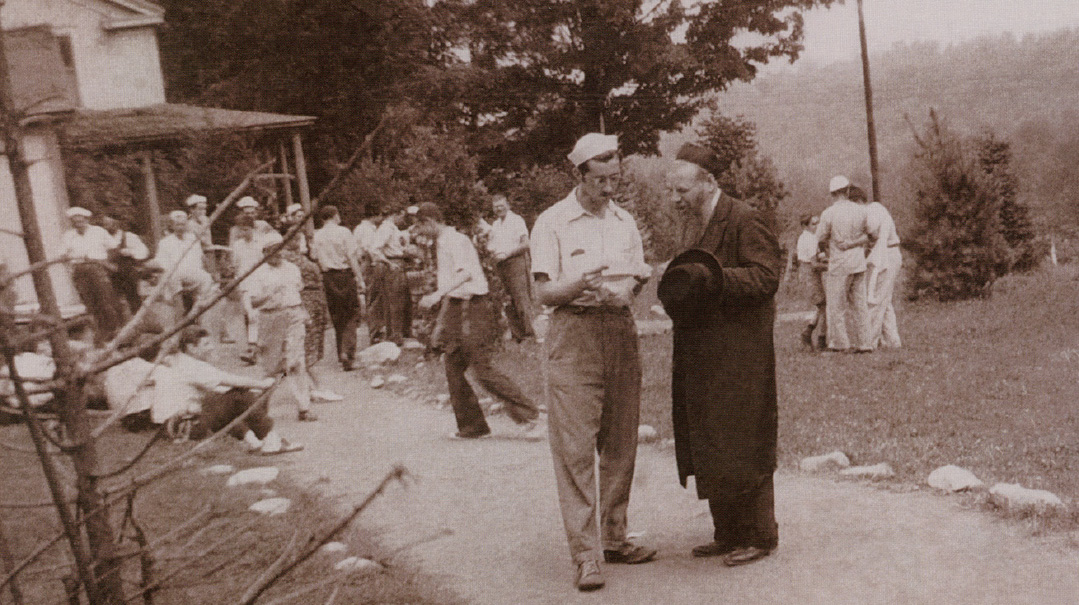
Rav Shlomo Heiman and Moshe Rapps in conversation at Camp Mesivta
To survey the landscape of Torah study in mid-20th century America was to behold the beginnings of an unexpected renaissance.
From the Midwest, where the glory of Telz was being restored, to the Mid-Atlantic region, from which proudly shone forth Rav Yaakov Yitzchak Ruderman’s Ner Yisrael, Jewish young men seeking quality Torah education now had some excellent options.
In New York City, America’s largest and most vibrant Jewish community was served by several advanced yeshivos, among them Mesivta Torah Vodaath (which also played a critical role in the origins of other yeshivos, such as Chaim Berlin and Lakewood). And on Manhattan’s Lower East Side, Rav Moshe Feinstein had gained renown as an institution unto himself, a wellspring of Torah wisdom and halachic guidance for petitioners from coast to coast.
Girls’ education, too, wasn’t left behind, as the likes of Rav Boruch and Rebbetzin Vichna Kaplan toiled to transplant the Bais Yaakov movement from its Krakow origins to the streets of Williamsburg and other Brooklyn neighborhoods.
These were relatively recent developments. Prewar America was a place of mass spiritual apathy and an era of rapid Americanization and assimilation. Torah Judaism was largely on the retreat, and every spiritual advance required tremendous grit and passion.
While every spiritual victory was hard fought, each had a unique narrative of struggle against adversity and indifference — no two battles (or those who waged them) were identical. And yet, for all the differences, each of the aforementioned legacy Torah institutions has a common thread woven into the fabric of their origin stories: Rav Yehuda Heschel Levenberg, and his Yeshivah of New Haven.
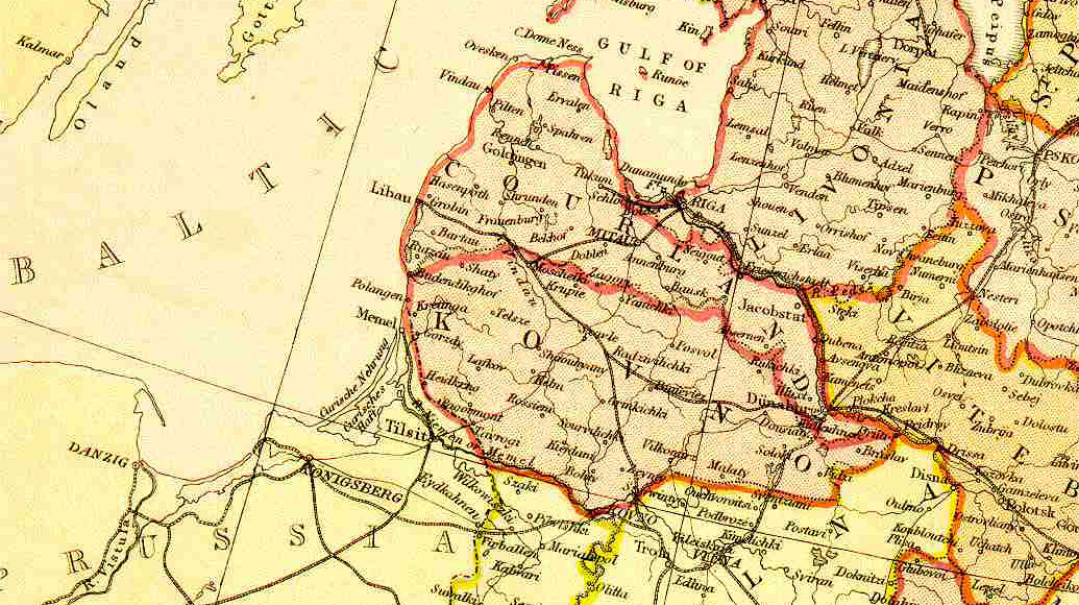
Chapter 1
THE GREATNESS WITHIN
A Mother’s Pride
ON a cold December day in 1884, Tzvi Hirsch and Chaya Gella Levenberg had more than just Chanukah to bring joy into their home. The poor yet respected Levenberg family of Pilten, in the Courland region of the Russian Empire, had welcomed a new child into the world. They named him Yehuda Heschel.
Born in the Russian Empire during a time of great upheaval and change, young “Yudel,” as he was affectionately called, was an energetic and occasionally mischievous child who quickly learned to pour his boundless passion into his Torah studies. Not long after he learned how to read, he devoted himself to learning Chumash. Neviim and Kesuvim also captured his imagination. Many a time he was spotted climbing into bed, Tanach in hand, immersed in the sacred words until sleep overtook him.
As one childhood melamed remarked to Yudel’s brother, Rav Boruch Zelig (1879-1941), “Whatever complaints I have about Yudel melt away when I watch him sit down to learn with such energy and passion.” This dedication was matched only by Yudel’s sensitive heart and strong moral compass. On one occasion, when a melamed handed Yudel his stick and instructed him to hit a lazy fellow student, he absolutely refused, in an early demonstration of his compassionate spirit.
As a child, he voraciously consumed stories of tzaddikim, especially those with mussar themes. His friends would often gather round, begging him to recount the inspiring tales — foreshadowing his future renown as a spellbinding orator.
But the true fountainhead of Yudel’s inspiration was undoubtedly his righteous mother. The Levenberg children shared vivid memories of their mother reciting Tehillim, pouring her heart out while singing her praise to the One Above for the opportunity to raise her children in the ways of Torah.
Working tirelessly to obtain the means to provide her children with a Torah education, she would collect leftover groceries to put food on the table. Clothing her children was another struggle. Concerned for modesty, she gave Yudel an old, long coat to conceal his torn trousers.
Yudel felt unfortunate and dejected that his parents were so poor. He was often mocked by his peers and called various demeaning names. If he saw one of his classmates outside of school, he would run away, heart aching.
But as he grew older, he overcame his shame and made peace with his family’s financial status. Most importantly, he learned how to channel this experience into a lifetime of helping others and sympathizing with those most in need.
Later in life, Rav Levenberg would share with his students an unforgettable episode seared into his memory from his formative years. He described a bone-chilling winter night he spent awake learning in the town’s beis medrash. Illuminated only by the flicker of a lone candle, he sat hunched over a pile of seforim, voice rising and falling with the ancient cadences of the Gemara.
Suddenly, young Yudel was startled by the creak of the ezras nashim door. For a moment, a wave of terror washed over him — was it the deranged woman known to haunt the town’s dark streets?
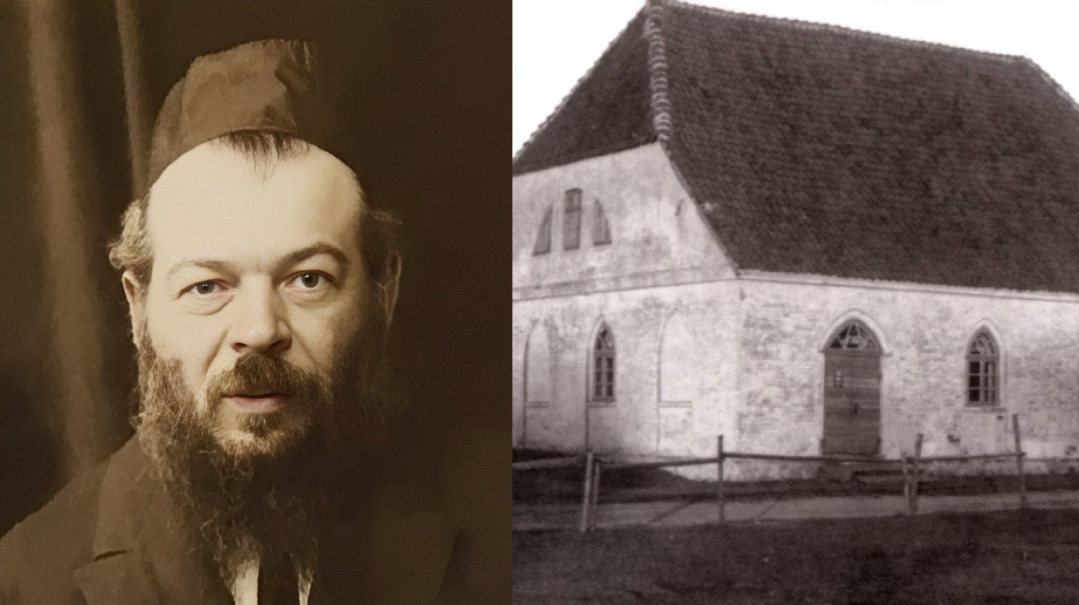
Like his younger brother, Rav Boruch Zelig Levenberg — Rav of Talsen and martyred by the Nazis alongside his townspeople — was a proud Slabodka graduate
A soft cough broke the silence, followed by a voice he knew better than his own: “Yudel, it’s your mother! Don’t stop learning for even a moment!”
In the frigid night, his mother had stolen into the empty shul to catch the sweet strains of her son’s learning. Yudel’s melodic chant reverberating through the beis medrash was at once his mother’s deepest comfort and the prompt for flowing tears.
“That moment,” he would later say, “illuminated the darkest days of my life. The memory of those times — when I was destitute in everything but Torah — revived and sustained me.”
Spurred by his parents’ mesirus nefesh, Yudel embarked on his yeshivah journey at a young age. He learned in local yeshivos in the greater Latvian area, among them Zager (the hometown of Rav Yisroel Salanter), Novoaleksandrovsk (where Rav Raphael Shapira [1837-1921] had once served as rav), and Leckava, where his growth enabled him to advance to one of the formative yeshivos of the time.
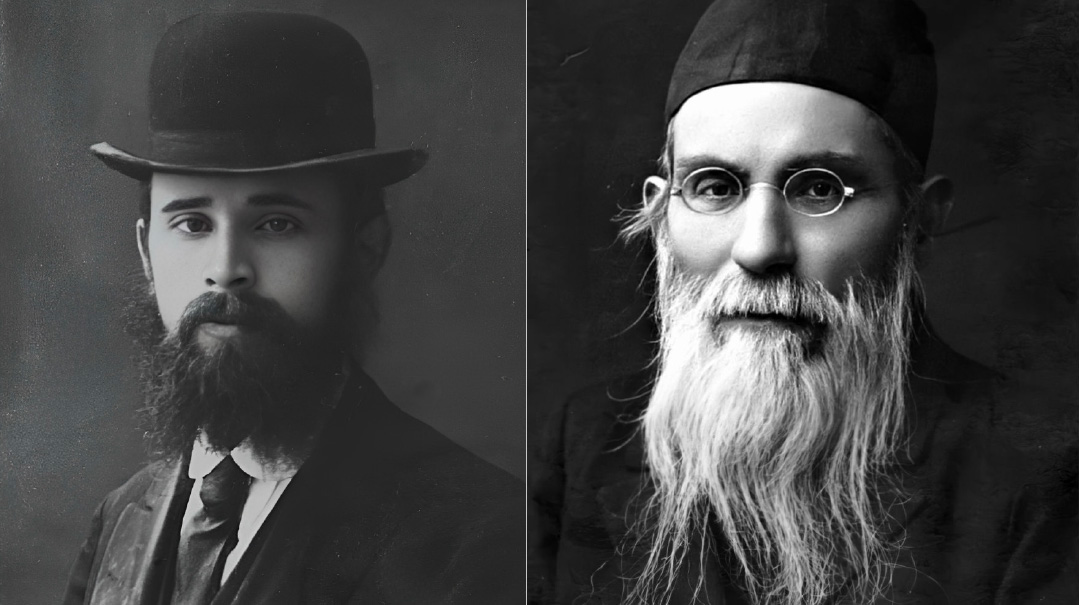
(Left) Over 60 years after they studied in Maltch, Rav Yechezkel Sarna would endorse Rav Yudel for his superior oratory skills that “would bring the Jewish people closer to their Father in Heaven”; (Right) The Alter of Slabodka helped mold great roshei yeshivah such as Rav Aharon Kotler, Rav Avraham Kalmanowitz, Rav Reuven Grozovsky, and Rav Yechiel Mordechai Gordon, and honed dominant mussar figures, including Rav Yerucham Levovitz, Rav Avraham Grodzinsky, Rav Meir Chodosh, and Rav Leib Chasman, to shape the next generation
Mentor for Life in Slabodka
Just a few months after Yudel was born, Rav Zalman Sender Kahana-Shapiro (1850-1923) was appointed the rav in the city of Maltch (Malech or Malec, in present-day Belarus). As a descendant of Rav Chaim Volozhiner (1749-1829) and one of the exceptional students of his cousin the Beis HaLevi (1820-1892) in the Volozhin Yeshivah and later in Slutzk, where the Beis HaLevi was rav, his credentials were impressive.
In 1898 Rav Zalman Sender was offered a position as rosh yeshivah in Knesses Beis Yitzchak in Slabodka (which ultimately was taken by Rav Boruch Ber Leibowitz). In an effort to convince him to stay in Maltch, community leaders offered to open a yeshivah for him there. Yeshivas Anaf (branch of) Etz Chaim, named for his alma mater of Volozhin, was the result of this arrangement.
Maltch would become an important feeder institution for the great yeshivos of Lithuania, Knesses Yisrael in Slabodka in particular. Rav Aharon Kotler (1892-1962), Rav Yaakov Kamenetsky (1891-1986), Rav Yechezkel Sarna (1890-1969), Rav Avraham Jofen (1887-1970), Rav Isser Yehuda Unterman (1886-1976), and Rav Zalman Sender’s son Rav Avraham Dov-Ber Kahana-Shapiro (1873-1943) (the Dvar Avraham) were among those educated in the yeshivah, which was transported to the larger town of Krinik when Rav Zalman Sender assumed the rabbinate there in 1903.
Yudel Tolshiner (his family had since moved to the Courland town of Talsen or Talsi, as it’s currently known) was quick to adapt to the higher level of learning in Maltch. But it was the next leg of Yudel’s journey that would truly set him on a path to greatness. At the urging of his brother Rav Boruch Zelig, Yudel transferred to the Slabodka Yeshivah. There he became a devoted talmid of Rav Nosson Zvi Finkel (1849-1927), the Alter of Slabodka, a towering figure who revolutionized the yeshivah world with his innovative and uncompromising approach to mussar.
Gadlus Ha’adam — the greatness inherent in man — was the theme of the first shmuess a young Rav Nosson Tzvi had heard from his own teacher the Alter of Kelm, and it became the conceptual cornerstone upon which the edifice of Slabodka was built. Every teaching of the Alter seemed to be a further exploration of the tzelem Elokim of each individual, and his firm belief that man contained a reservoir of potential waiting to be actualized. He taught that mussar has the capacity to unveil and neutralize those forces preventing man from realizing his full potential. This concept, which emphasized the inherent greatness and potential within every individual, became the foundation of the Slabodka Yeshivah.
The Alter’s philosophy had a profound impact on his students, and Yudel was no exception. He internalized the Alter’s teachings, understanding that true greatness meant setting high expectations for oneself and constantly striving to reach one’s full potential. As he grew in his own learning and character development, he emerged as a natural leader.
“Der groiser baal regesh fregt — the greatly sensitive one asks,” the Alter of Slabodka would often mention while delivering a shmuess, and then he would elaborate on that point. Who did the Alter consider the “greatly sensitive one”? Yudel Tolshiner.
The bond between rebbi and talmid was a deeply personal one. Early on, the Alter recognized Yudel’s depth of feeling, goodness of heart, and genuine love for Hashem and His children. He saw in him a kindred spirit, a soul alight with the fire of Torah and the desire to serve the wider community. He took the young man under his wing, engaging him in lengthy discussions of mussar and life’s goals.
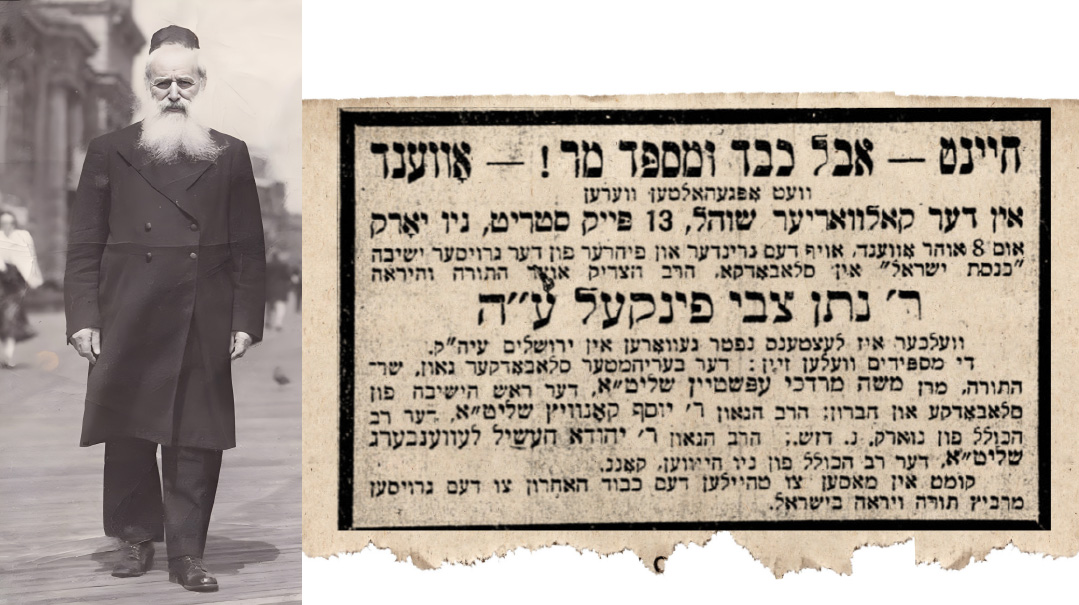
Rav Eliezer Poupko
Divine Symphony
Years later, following the Alter’s passing in the winter of 1927, Rav Levenberg addressed a large memorial gathering at the Pike St. Synagogue on the Lower East Side, speaking alongside the Alter’s longtime partner, the Slabodka rosh yeshivah Rav Moshe Mordechai Epstein (who was in the United States on a visit to raise funds and recruit students for the Slabodka yeshivah in Chevron). During the course of his two-hour hesped, Rav Levenberg shared a powerful firsthand experience:
When I studied in Slabodka, they used to raffle off barrels of petroleum, which the winner would then donate back to the yeshivah to keep its kerosene lamps lit. Pairs of students from the yeshivah would go around the Jewish homes in Kovno to sell them raffle tickets for the oil.
Once, the Alter sent me along with my friend Eliezer Poupko (1886-1961) from Radin (later a rav in the city of Haverhill, Massachusetts) to sell raffle tickets. Being young and naturally shy, I tried to avoid this mission, but the Alter insisted firmly, and I went. However, I devised a strategy. Every time we approached a house, I would open the door and push my friend inside, and I would stay outside.
When we returned to the yeshivah, my friend complained to the Alter about my strange behavior. The Alter called me in and said: “What do you think, that I have no one else to send in your place? There are plenty of students who could go. But I see in you a great shyness, and because it’s possible that one day you’ll need to knock on the doors of the generous, I want you to get used to it.”
When I came to America and entered the world of public service, I realized how right the Alter of Slabodka, of blessed memory, was. Not only was the Torah of Hashem constantly on his lips, but he also cared, like a compassionate father, for the future of his students. With his sharp eye, he penetrated the depths of their souls and natures, and tried to educate them and elevate them to the level of perfection.
His davening was indescribable. A fellow Slabodka student, Yisrael Chaim Becker, was told by the Alter, “If you want to hear someone daven properly, I advise you to daven along with Yudel from one siddur.” The student described the davening as pouring from the soul of Yudel. “He hypnotized me. I heard his davening as a G-dly symphony, singing and praising the Creator.”
(Rav Shmuel Schechter later described how Rav Levenberg’s great characteristic was that he was an oved Hashem. “We saw that when we were in Kleinberg’s Hotel when he was sick, he was very sick already, very sick, but the way he used to daven and the way he said Aleinu. The way he said aleinu l’shabei’ach in his matzav of yissurim — it was a culmination of a whole lifetime of avodas Hashem.)
Yudel’s time in Slabodka coincided with the great split in 1897 between the pro- and anti-mussar factions in the yeshivah. Reb Yudel entered the fray and thus gained firsthand experience understanding the dynamics of the opposing forces.
The writer, educator, and doctor Hirsch Leib Gordon (1896-1969), who studied in Slabodka before coming to the US, was a regular visitor to Rav Yudel’s home as a student at Yale. He wrote of Rav Levenberg’s valiant efforts to defend the Alter’s ideals, even sometimes having to use physical force to keep away his mentor’s detractors.
In 1904, young Yudel was ordained by a trio of leading Lithuanian rabbinic giants: Rav Moshe Mordechai Epstein (1866-1934), his rosh yeshivah in Slabodka; Rav Aharon Walkin (1865-1942), the rav of Pinsk; and Rav Zev Wolf Avrech (1845–1922), the rav of Mazeikiai and the author of the responsa Revid HaZahav. Yudel Tolshiner was now Rav Yehuda Heschel Halevi Levenberg.
Revolutionary Fervor
As Rav Yudel prepared to leave Slabodka, a storm was brewing across the Russian Empire. Russia’s humiliating defeat in the Russo-Japanese War ignited a wave of unrest. The fast-moving current of the 1905 Revolution sucked in many youngsters, Jews included, seeking to exchange a life of hard work, poverty, and government oppression for the seemingly exhilarating role of a revolutionary.
The young Jews among these revolutionaries targeted their fellow Jewish youth, sometimes entering yeshivos while shouting slogans for the socialist Bund or other revolutionary parties and spreading propaganda. In his book With Fury Poured Out, Rabbi Bernard Maza (1926-2007) tells the troubling tale of a group of Jewish revolutionaries in Rokiskis, a town that stands on the current-day border of Lithuania and Latvia:
In 1905 a Jewish revolutionary group was formed in Rokiskis, spreading proclamations and organizing demonstrations against the Czar. The Jewish revolutionaries learned to handle revolvers on the Sabbath in the Rokiskis woods.
The story is told that a man named Velvele and his two sons spied upon the revolutionaries, and because of them, some of the revolutionaries were sent to Siberia. The revolutionary group decreed the death sentence against Velvele and his sons.
One Simchas Torah holiday in the morning, when the spies were in the beis medrash, they were shot at. But because the attackers did not want to hurt innocent people in the beis medrash, they only slightly wounded the spies. The boys who made the attack fled from the scene. Some were caught and sent to Siberia.
Amid this turmoil, Rav Yudel returned to his hometown of Talsen in the Courland district, a region with its own complex history. Situated north of Lithuania as the westernmost province of the Russian Empire, Courland was heavily influenced by its proximity to Germany. It was a region steeped in German culture and language, despite it being under Czarist rule since 1795.
Courland’s exclusion from the Pale of Settlement, the designated area where Jews were allowed to reside within the empire, further reinforced their distinctive identity. While this exclusion was not strictly enforced, it nonetheless contributed to a feeling of separateness, and a reluctance to fully integrate into the broader Russian Jewish community.
Being outside the Pale in both the literal and figurative sense left Courland’s Jewish population relatively demographically sparse, and they considered themselves more “western” and cultured than those within the Pale. In fact, many Jews in Courland spoke German rather than Yiddish.
This sense of distinctiveness, however, did not shield Courland’s Jews from the hardships that plagued the empire. Poor living conditions, economic instability, and religious restrictions fueled discontent among the Jewish population. As revolutionary ideologies like Marxism and socialism gained traction among the youth, the stage was set for a perfect storm of unrest.
The Cossacks’ Wrath
On that fateful day, December 5, 1905, the tranquil town of Talsen found itself engulfed in the flames of revolution. A legion of Cossacks, their hearts hardened and weapons poised, descended upon the town to quell the uprising with an iron fist. The air crackled with the sound of gunshots as the Cossacks fired indiscriminately, killing more than 20, among them several Jews, both revolutionaries and innocent people trying to flee. They pillaged with impunity, leaving a trail of destruction in their wake.
Rav Yudel ran for his life, fleeing his regular place in the attic of the local shul. In that moment of terror, he stumbled upon a wounded Russian man who was bleeding heavily. Rav Yudel mustered every ounce of his strength and carried the injured man up to an attic. He tore his own shirt to create makeshift bandages, tending to the man’s wounds with gentle hands and a compassionate heart. In a time when aiding revolutionaries was punishable by death, Rav Yudel risked everything to save a human life.
Once the revolutionary’s wounds were stabilized, Rav Yudel ran onward. He sought refuge in a house outside town, but the homeowner was already housing many men, women, and children. In a time of such turmoil, the presence of a young man of military age could put everyone at risk. Rav Yudel understood that he was not welcome — yet he felt no bitterness or resentment. Instead, he praised the homeowner for sheltering so many hapless souls. Then, he pressed on and found a hovel where he could hide.
As the third day of hostilities drew to a close, the Russian forces finally permitted the burial of the bodies that littered the streets. Fear still gripped the town, and few dared to venture out. Once again, Rav Yudel stepped forward, his courage fueled by his commitment to bring kevod acharon to those who were murdered. He braved the streets, recovering the bodies, cleaning the blood off the sidewalks and ensured a proper kevurah even for those completely disconnected from traditional Jewish life.
In the aftermath of the revolution, Rav Baruch Zelig found his brother in the attic of the shul, alone and weeping. His tears flowed not for himself, but for the plight of the Jews in Talsen and the surrounding towns — an expression of his deep love for his fellow Jews.
Rav Baruch Zelig later shared a poignant anecdote that illuminated his brother’s profound bitachon. When the dreaded conscription order from the Russian army arrived, Rav Yudel’s family was gripped by worry, knowing all too well the hardships and dangers that awaited Jewish soldiers in the Czar’s ranks. Desperate to spare him this fate, one of his elder siblings, who had found financial success in distant South Africa, sent a substantial sum of money, hoping it would be enough to sway the notoriously corrupt draft board.
Yet when Rav Yudel emerged triumphant, exemption in hand, he revealed that the funds had not been used as a bribe, but rather to acquire seforim. For Rav Yudel, this was not a gamble, but an act of pure faith, rooted in the timeless wisdom of Rav Nechunya ben HaKanah, who taught in Pirkei Avos: “One who accepts the yoke of Torah, absolves himself of the yoke of government [oppression].”
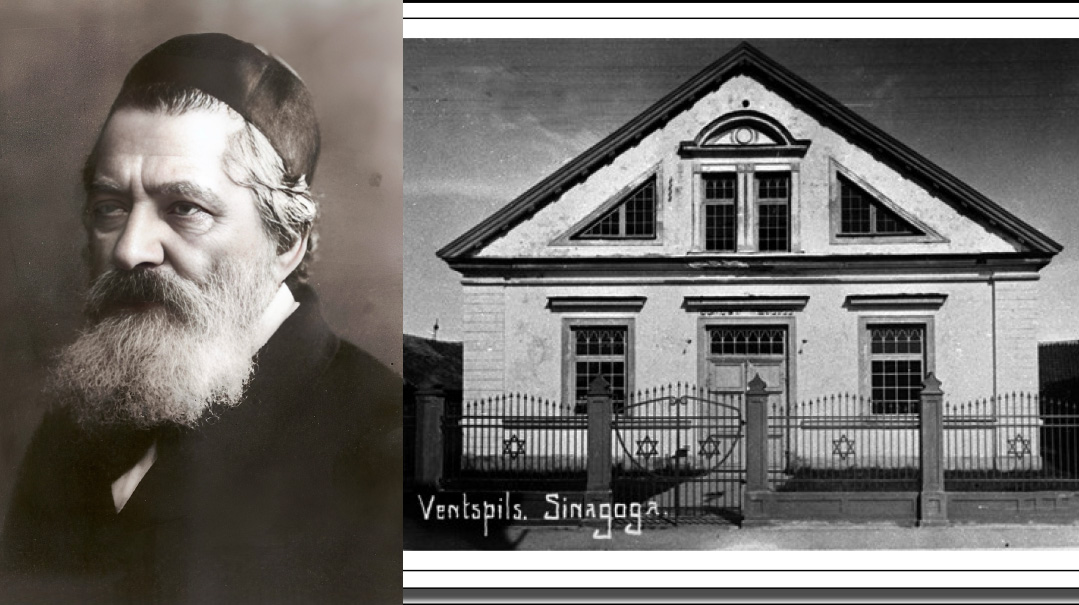
Rav Epharim Samunov and the shul in Windau
A Dowry Forgone
The following year, Rav Yudel became engaged to Devora Edelstein (1882-1944) of Windau (Ventspils), a port city on the Baltic Sea. Shortly thereafter, he discovered that much of what he’d been promised financially was false; his future mother-in-law had relied on funds she had hoped her sons in the US would send as a dowry.
Not wanting to break the engagement, Yudel traveled to Kelm, hoping the situation would sort itself out in the interim. After six months it became apparent that no change would be forthcoming. He telegraphed Mrs. Edelstein that he was forgoing any financial claim, and the wedding would proceed as planned. (Exhaustive research by the acclaimed genealogist Chaya Sarah Herman turned up records that show that a dowry was indeed recorded, so it’s possible that the funds came through at the last moment.)
The wedding took place a week after Shavuos of 1907. Their mesader kiddushin was the rav of Windau, Rav Ephraim Samunov (1860-1932), an esteemed musmach of Volozhin who was the son-in-law of Rav Chaim Berlin (1832-1912). (Rav Ephraim, who was well-schooled in the Russian language, helped defend the yeshivah before Russian authorities who demanded that secular studies be included in the yeshivah’s curriculum. Together with Rav Chaim Soloveitchik (1852-1918), he drafted the yeshivah’s position and the lobbying letters that the yeshivah management tried to implement.)
For the first years of his marriage, Rav Yudel lived in his wife’s hometown, organizing shiurim for local youth. Many of these youths attended the local gymnasium, and due to his influence began to abstain from writing on Shabbos, to the consternation of the gymnasium director and some of their parents.
When his mother-in-law’s business dealings became increasingly precarious, Rav Yudel took on loans to assist with the family’s finances. By 1910 his debts were mounting, and he realized something had to change. So in early February, he traveled back to Slabodka to seek guidance.
Rav Levenberg’s trip to Slabodka coincided with a period of sorrow. The rabbanim of both Kovno, Rav Tzvi Hirsch Rabinowitz (1848-1910), and the neighboring suburb of Slabodka, Rav Moshe Danishevsky (1830-1910), had passed away two weeks apart. Hespedim were organized in a large Kovno shul. The Slabodka talmidim urged Rav Yudel, who was known as a skilled orator, to deliver a eulogy.
He appeared on the bimah with a Midrash Eichah in his hands. It didn’t take long for the tears to start flowing. The crowds were so large that 15 minutes into the speech, people began fainting from the overcrowding, upon which the speech was abruptly halted. But even those who had not been familiar with the star Slabodka talmid from his time as a student there five years earlier, were now aware of his talent.
The Slabodka Yeshivah extended an invitation to Rav Yudel, proposing that he become their fundraising emissary in America. This offer seemed to echo the foresight of the Alter, who had apparently predicted such a role for Rav Yudel during his reluctant fundraising stint back when he’d been a student at the yeshivah. After careful consideration, the proposal set forth by Rav Moshe Mordechai Epstein was accepted.
Consequently, Rav Levenberg prepared to embark on a new chapter in his life, making arrangements to immigrate to the United States and undertake his new responsibilities.
It should be noted that economic hardship was not the only motivation for Rav Levenberg to immigrate. Decades later, Rav Yitzchak Hutner (1906-1980) would reflect that Rav Levenberg’s journey to the United States in 1910 was the very first transatlantic migration undertaken solely l’Sheim Shamayim, for the purpose of spreading Torah and Yiddishkeit in the spiritual wasteland of early 20th-century America.
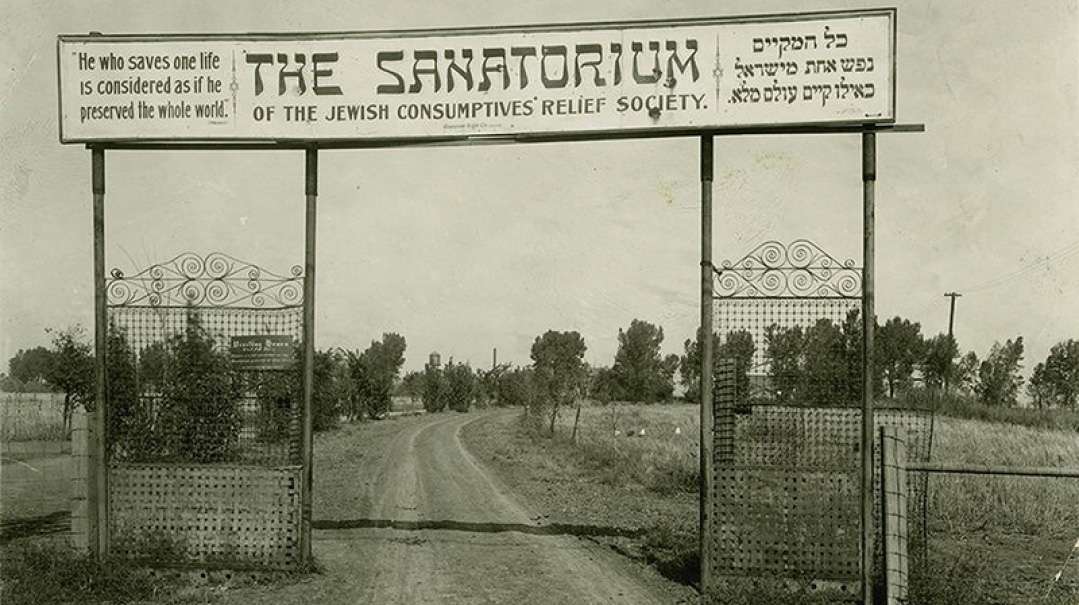
The National Jewish Hospital for Consumptives was what brought many Jews out to Denver in the early 20th century
Chapter 2
VISION FOR THE NEW WORLD
The Rabbi of Jersey City
Rav Yehuda Heschel Levenberg sailed on the USS Pretoria from Hamburg on March 12, 1910, and arrived in New York City on March 25. While he would continue raising money for Slabodka for the next 28 years in his role as the president of the yeshivah’s robust alumni association, he quickly learned that America had no shortage of meshulachim and that his talents could be utilized in other ways.
By the summer of 1910, he had accepted an offer to serve as rav of several Eastern European congregations in Jersey City, New Jersey. The famed writer and activist Peter Wiernik (1865-1936) editorialized Jersey City’s good fortune in Der Morgen Zhurnal, congratulating the city’s Jews on gaining “this most learned and talented man,” as their new spiritual leader.
At the tender age of 25, armed with the eternal truths of Slabodka, Rav Levenberg stood poised to enter an American rabbinate that lacked young, energetic idealists. His devotion to every communal cause would redefine the local Jewish landscape, improving essential institutions such as the local Talmud Torah and the Jewish Children’s Home, as well as the city’s Jewish old-age home. As his renown grew, stories of quiet chesed surfaced.
Rabbi Mordechai (Max) Robinson of Denver (1886–1951) related one such episode to Rabbi Levenberg’s son-in-law and biographer Rabbi Yitzchok Tzvi Ever (1913-1971) in 1939:
One of the teachers at the Jersey City Talmud Torah that Rav Levenberg founded suddenly fell ill with an infectious lung disease, which at the time had no known cure. It was thought that the clean air and sunshine in Colorado could cure this disease, so he journeyed to Denver and was admitted to the National Jewish Hospital for Consumptives for treatment.
He soon took a turn for the worse, and doctors declared that they needed to operate or it was unlikely he would ever recover. The simple teacher, a recent immigrant, had borrowed money to get to Denver and lacked even a dollar to pay for the costly procedure. After much deliberation, he wrote a letter to Rav Levenberg in Jersey City, explaining the situation and that he absolutely needed several hundred dollars for an operation, otherwise, he would succumb to blood poisoning throughout his body.
Before long, he received a special delivery letter with a check signed by Rabbi Levenberg. Upon further examination, he realized that the amount was blank. Rav Levenberg enclosed a letter in which he clarified that the patient should write the amount needed on the check, but instructed him that it should not exceed five hundred dollars — “because I don’t have more in the bank than this amount.”
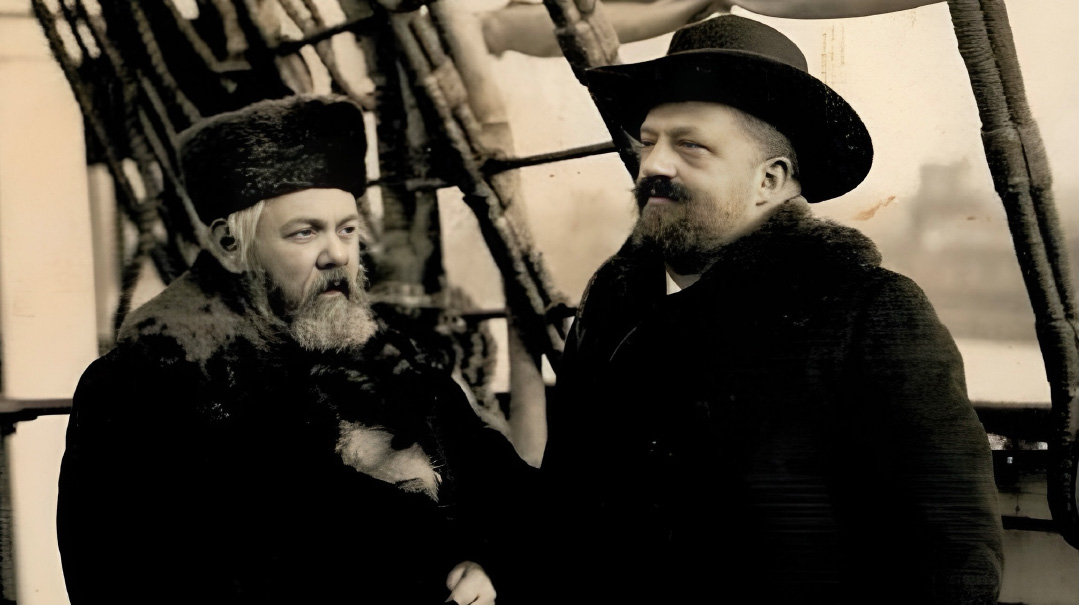
Rav Aharon Walkin, rav of Amtsislav, was tapped to take part in a mission to the United States along with Rabbi Dr. Meir Hildesheimer, the head of the Rabbinical Seminary of Berlin, on behalf of the Agudah
From Words to Action
In 1913, a delegation consisting of Rav Aharon Walkin and Rabbi Dr. Meir Hildesheimer (1864-1934) was sent to America to heighten awareness of the nascent Agudath Israel movement, which had been founded a year earlier in Katowice, Poland. As they searched for a spokesman to commence operation in America, they realized that the young, dynamic rabbi of Jersey City was the perfect candidate. His speeches attracted packed crowds, and he knew how to share a message with crowds both young and old.
The proposed launch of Agudath Israel in America did not get very far. The 1914 Knessiah Gedolah was postponed for nearly a decade due to the outbreak of the First World War. American Jewry united to help their suffering brethren overseas. Within a few months, Rav Yehuda Heschel was leading large rallies and fundraising events on behalf of the newly formed Central Relief Committee. A Jersey Journal reporter who was dispatched to cover one such event in February 1915 was transfixed by the young rabbi and shared an excerpt from his speech:
“Blood is flowing like water,” he said. “Aside from the question of war and its countless miseries, thousands, yes, tens of thousands of our poor coreligionists are actually starving: old men who never knew what want was, women whose husbands are at war, children and babies in arms, all are longing for that with which to keep their souls and bodies together, a little food upon which they can exist until conditions improve. They are crying aloud for a little help, and this help must come from us, the Jews of the United States.”
Our previous speakers have all lamented the overwhelming number of victims of this tragedy. Perhaps we should also consider its qualitative impact, which cannot be quantified or measured by any means.
What if George Washington had lost the war against England, and America had never come into being? Not only would America have suffered, but the entirety of humanity would have been altered, and Washington could have easily lost the war were it not for a Polish Jew named Haym Solomon, who contributed 600 thousand dollars. What if the Maccabees had not triumphed over the Greeks? The world would have been a markedly different place.
Who can predict the future of Judaism and humanity itself if we allow our brethren in Europe to perish? We must, therefore, be filled with a strong desire to repair and restore, not merely with words, but through genuine actions that show solidarity and empathy with the plight of our brethren in Europe. Then, as a result of our deeds, our Father in Heaven will extend His hand to us, end this senseless suffering, and guide us back to our true home.
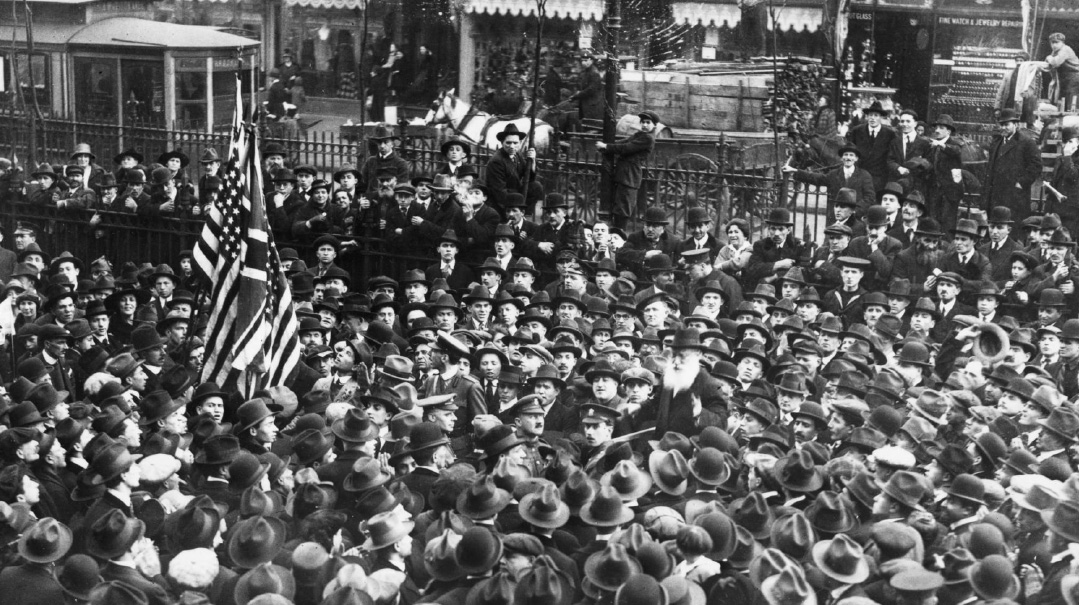
Rav Moshe Zevulun Margolies (Ramaz) blesses a battalion of Jewish soldiers prior to their deployment overseas. In addition to raising funds for relief, rabbanim also worked to raise the spirits and religious conditions of troops being sent off to war
His impassioned pleas bore fruit. One month later, the same newspaper reported that 3,000 pounds of matzah were being sent to the besieged Jews of Palestine, who were trapped between the warring Ottoman and British militaries. The Jews of the Yishuv were starving and could not even afford basic religious necessities such as matzah for Pesach.
Rav Yudel’s speaking abilities were such that even local Reform Jews began to attend Jersey City’s B’nai Israel shul to hear his sermons. When he campaigned to build a new Talmud Torah in town, the local newspaper described how he had obtained funding from the wealthier Reform Jews, who most certainly had never before supported an old-world Orthodox institution.
But while his position as rav allowed him to have an impact on Jewish life and to support his family, Rav Levenberg felt unfulfilled. He wondered how he could fulfill his sacred calling, the Alter’s charge: to ignite the hearts of a generation with the light of Torah. That opportunity would soon arrive.
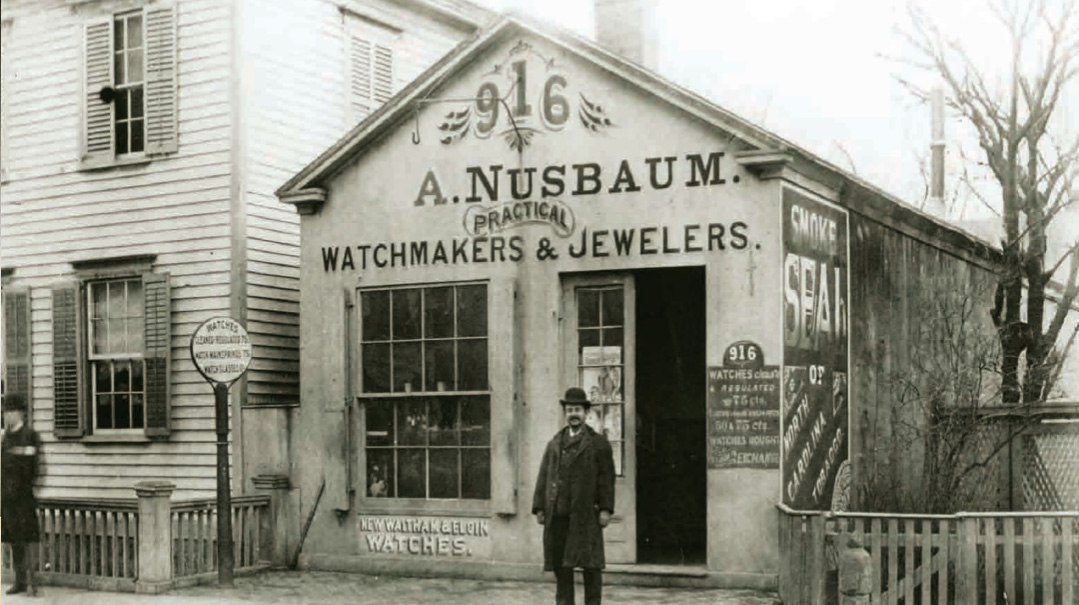
A Jewish proprietor outside his store in New Haven, early 1900s
New Horizons in New Haven
In 1916 Rav Levenberg was invited to visit New Haven, Connecticut to address a large community gathering in support of the war relief effort. He made a profound impression on his listeners and a group of community leaders invited him to move there and assume the helm of one of the local shuls — an offer that he accepted.
The community in Jersey City, devastated by the news of Rav Levenberg’s impending departure, promptly summoned the New Haven kehillah to a din Torah, but it was ultimately decided in favor of New Haven. At a farewell ceremony in Jersey City, which lasted until four a.m., Rav Levenberg was presented with a gold watch and an expensive walking stick. The Jews of Jersey City then voted to postpone the search for a replacement for a full year, hoping that, in the interim, perhaps Rav Levenberg might be persuaded to return.
As Rav Ha’ir, the chief rabbi of New Haven, Rav Levenberg commanded universal respect throughout the community, despite not receiving a direct income from his esteemed position. The eight volumes of the journal Jews in New Haven are loaded with testimonials to his selflessness and dedication while tending to the spiritual needs of his congregation.
Though his main pulpit was the majestic Rose Street Synagogue, B’nai Israel — the largest Orthodox shul in New Haven — his influence extended far beyond its walls. He gracefully circulated through all the local shuls, delivering powerful sermons that left an indelible mark on the hearts of his listeners.
Sarah Moore Lipwich vividly recounts a moving experience at the small Bradley Street Shul during the High Holiday season. “The shul was filled to capacity and was overflowing with standing room only, eagerly awaiting the presence of Rabbi Levenberg. As he graced the bimah and delivered his sermon, his words were so poignant that not a single eye remained dry in the congregation.”
Similarly, one Sam Dimenstein describes the profound impact of Rabbi Levenberg’s oratory skills at the old Congregation Sheveth Achim on Factory Street. “The dark-bearded rabbi’s dynamic and charismatic derashos were so effective that women seldom left the synagogue without shedding tears, deeply moved by his words.”
His son Rav Tzvi Hirsch (1922–2017), a longtime rebbi at Yeshivas Rabbeinu Chaim Berlin and the son-in-law of Rav Moshe Shatzkes (1881-1958), shared how Rav Levenberg’s influence extended beyond the Jewish community, as evidenced by the governor of Connecticut’s remark after hearing him speak: “If I could speak as well as you, I would already be president of the United States!” This despite the fact that the speech was delivered in Yiddish, a testament to Rav Levenberg’s ability to captivate audiences regardless of language barriers.
Even the gentile superintendent of the local Jewish nursing home found himself drawn to Rav Levenberg’s lengthy Yiddish speeches, standing in the corner and listening intently despite not comprehending the language. When asked about his regular attendance, the superintendent replied, “This man speaks from the heart, and that alone is worth listening to.”
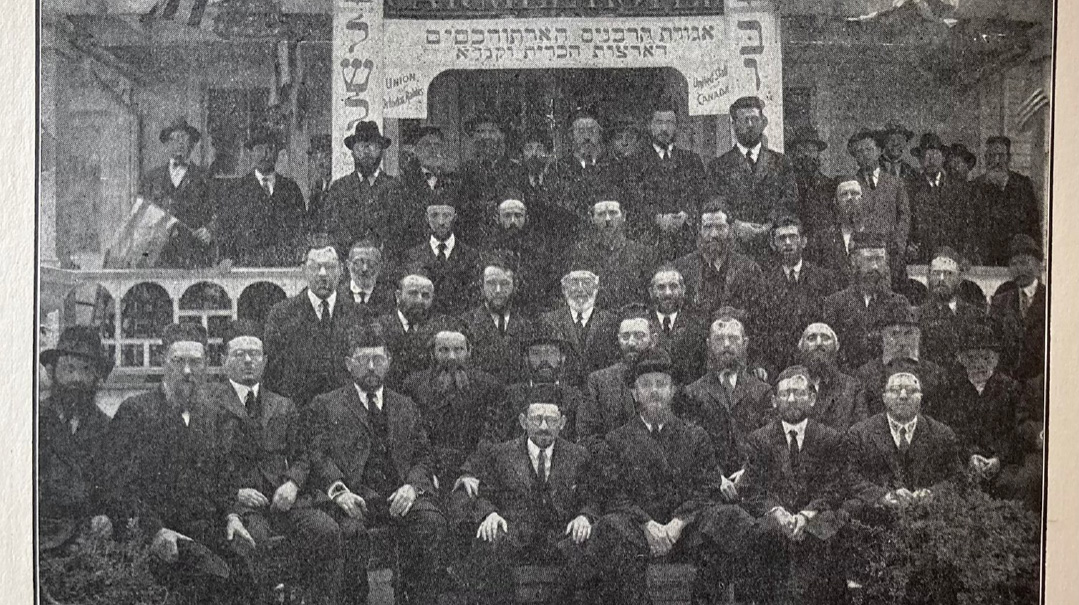
Outside Lakewood’s Carmel Hotel at the Agudath Harabonim’s 20th- anniversary convention in 1923
Only with Unity
But stirring speeches could go only so far. Rav Levenberg realized that in order to truly succeed as chief rabbi, he had to unify the city. He began to advocate for the organization of a Vaad Ha’Ir, a Jewish Community Council. He presented the idea to hundreds of community members:
Today’s assembly is not focused on merely one of our Jewish institutions. It is a much broader approach we are envisioning, that of a total effort that will lead to a united Jewish community endeavor with cohesive leadership concerned with all Jewish areas of endeavor.
Why is this so urgently needed? To offer but one example: the New Haven Community Chest gives its support to a variety of non-Jewish institutions. Our only beneficiary to date is the old-age home. We have no way of providing for the welfare of our needy. There is no shelter for the poor who arrive among us; there is no provision made for a kimcha d’Pischa fund. Above all, we are sorely in need of a proper Jewish educational system. Few, if any, of us have demonstrated dedicated work on behalf of that critical need.
I have decried this sad situation previously, and I shall continue to do so until the message strikes home to each and every one of you! Kashrus, Shabbos, mikveh, and the upbuilding of Eretz Yisrael, all of these demand our most dedicated attention and effort. We must become a united army to achieve these sundry goals. The Vaad Ha’Ir must be established for united planning and implementation.
Thus, the central Jewish coordinating body, the New Haven Vaad Ha’Ir, came into existence. Many a communal leader would consider that a crowning achievement. But for Rav Levenberg, it was just seen as a bridge to cross into new territory. He had been molded by a yeshivah, he knew the power of the yeshivah, and he wanted to bring that singular force to the Jews of his new country.
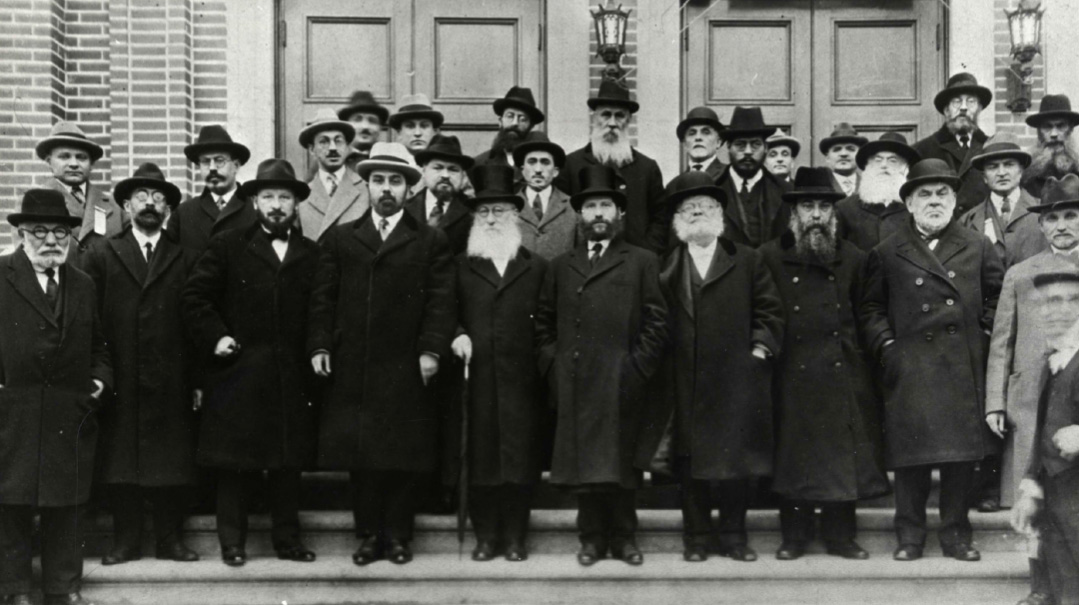
Rav Eliezer Silver was a steady supporter of the Yeshivah throughout its existence, so it was only natural that both Rav Levenberg and Rav Kramer attended his installation, in 1925, as Rabbi of Springfield, Massachusetts (an hour north of New Haven). Front row, left to right: unidentified; Dr. Samuel Friedman; Rabbis Bernard Revel; Yisroel Rosenberg; Moshe Zevulun Margolies (Ramaz); Eliezer Silver; Bernard Levinthal; Sheftel Kramer; Baruch Epstein (author of the Torah Temimah). Between Rabbis Rosenberg and Margolies is Rabbi Mayer Berlin. Between Rabbis Levinthal and Kramer is Rav Yehuda Levenberg. In the back, extreme right, is the Meitscheter Illui, with Rav Yehuda Leib Forer to his left
A Novel Proposal
In 1902, in the weeks following the tragic passing of Rav Yaakov Yosef, New York City’s Rav Hakollel, a group of European-born rabbanim from across the country gathered to appoint a successor. Though they were ultimately unsuccessful, they did establish a body devoted to furthering Yiddishkeit in America and strengthening its rabbinate.
The founders of the new organization, which they named Agudath Harabonim, didn’t trust the modern-looking, English-speaking and acculturated character of “Americanized Orthodoxy,” and drew its ranks exclusively from the pool of Eastern European immigrants in the rabbinate.
In April of 1923, the Agudath Harabonim announced that their 21st convention would convene the following month in the resort town of Lakewood, New Jersey.
The annual conference was an opportunity for those engaged in the lonely struggle of maintaining religious life among an increasingly disinterested public to meet one another, articulate the latest deteriorations in halachic observance, and propose strategies and solutions for those challenges.
Some of the assembled rabbanim at Lakewood’s Carmel Hotel, like the president of the Agudath Harabonim, Philadelphia’s Rav Dov Aryeh (Bernard) Levinthal (1864-1952), had been attending such events since the inaugural meeting. For others, such as Rav Yosef Eliyahu Henkin (1881-1973) — who had only just immigrated in February — this was their first encounter with the American rabbinic scene.
The convention of 1923 was consequential in several ways. A motion was passed to reform the internal leadership structure of the Agudath Harabonim, from a single president to a three-member presidium. This paved the way for the ascendancy of Harrisburg, Pennsylvania’s 41-year-old Rav Eliezer Silver (1882-1968) to a seat on the triumvirate, a position he would hold for the next 45 years.
Another hotly debated issue was the ongoing feud between the new Agudath Israel organization and the religious Zionist Mizrachi. Those gathered voted to send a delegation to both of the upcoming major Jewish conferences scheduled for the coming August: the 13th Zionist Congress (and the adjacent World Mizrachi Convention) in Carlsbad, Czechoslovakia, and the first Knessiah Gedolah of Agudas Yisrael in Vienna, in an attempt to broker a peaceful resolution.
On the evening of Thursday, May 10, the final night of the convention, Rav Eliezer Silver introduced a visiting guest from Poland, the 28-year-old Rav Menachem Mendel Kasher (1895-1983). Rav Silver presented the young visitor as the visionary behind a bold project to publish an edition of the Chumash, to be named Beis HaTalmud V’HaMedrash, which would juxtapose the rich treasury of Torah shebe’al peh with the pesukim of Torah shebichsav. Rav Kasher would indeed realize this vision, publishing 30 volumes of his (ultimately titled) Torah Sheleimah, beginning in 1927.
Following Rav Kasher’s speech, it was Rav Levenberg’s turn. Standing in a hotel on the corner of Princeton Avenue and Fifth Street, in the town that would be host to a world-class yeshivah two decades later, 39-year-old Rav Yehuda Levenberg began to describe his vision.
Land of Possibilities
The Yiddish journalist Ephraim Caplan (1878–1943), assigned to cover the convention by Der Morgen Zhurnal, filed the following report of his address, the final one of the conference (followed only by the brief installation ceremony of the new presidium):
It takes a while before he begins. His appearance is exceptionally pale, his eyes blaze fire through his glasses, and he sways as though in the middle of a deep sugya… eventually he starts:
“Rabbosai, Rabbanim, Gedolei Torah…
“For a long while now, I’ve been carrying with me a grand dream, which I have often considered beyond me. The dream comes to me, however, because when I was taking leave of Rav Nota Hirsh [Finkel], the Mashgiach of the Slabodka Yeshivah [13 years ago], he remarked: ‘You are setting out for America. It is a land of great possibilities. Go ahead and make it your task to establish a yeshivah of the Slabodka orientation.’
“I have no intention of competing with Yeshivas Rabbeinu Yitzchak Elchanan [RIETS] — it must continue to occupy its respected position. But I do believe that there is room in America for additional centers of Torah learning.
“I already have a seed fund of fifteen-thousand dollars. The laymen of New Haven are excited about the idea, and have committed to providing a structure for the yeshivah.
“Moreover, I have negotiated with Yale University, and they have agreed to accept any young man who has completed studies at a European yeshivah and can bring proper documents attesting to that fact.
“Moreover, students at the proposed New Haven Yeshivah will, after three or four years, be admitted to Yale, without having to waste time on secular studies. The primary concern of the students will be Torah study, to develop one’s self in learning, and to swim in the sea of Talmud.
“I ask of you for your endorsement of my plan, that my longtime dream may become a living reality.”
To Rabbi Levenberg’s plea, Rabbi Levinthal, president of the Orthodox rabbinic body, responded with enthusiasm: “Go forward with strength. We not only approve of your proposal, we will assist you in any way we are able.”
In his 2022 article, “The New Haven Yeshiva, 1923–1937: An Experiment in American Jewish Education,” Dr. Ira Robinson writes that the New Haven Yeshivah was a novel concept for America.
“The two major yeshivahs previously created, the Rabbi Isaac Elchanan Theological Seminary in New York, and the Hebrew Theological College of Chicago, were in the major tradition of ‘Lithuanian’ yeshivot founded in Eastern Europe in the nineteenth century,” he explains. “However, neither followed the mussar tradition emphasized in Rabbi Levenberg’s Slabodka Yeshivah. Perhaps spurred by the founding of the Hebrew Theological College in 1922, the first such institution established in North America beyond New York City.”
But the yeshivah was novel for other reasons as well. New York and Chicago were the epicenters of the American Jewish community. The yeshivah in New Haven was to be America’s first “out-of-town” yeshivah, far from the dense and distracting masses of the immigrant neighborhoods of the Lower East Side and Chicago’s West Side.
Furthermore, it was the first yeshivah founded solely upon the idea of “Torah lishmah” — a post-high school institute of full-time Torah learning, which wasn’t an outgrowth of a local elementary or high school and didn’t have a stated goal of rabbinical ordination as its official curriculum. (The younger, high school-age students at New Haven did in fact attend secular studies offsite, in accordance with State law.)
It’s unclear whether Rav Levenberg’s pioneering concept was taken seriously by his colleagues at the Agudath Harabonim. They were focused on boosting the struggling Yeshivas Rabbeinu Yitzchak Elchanan, which they hoped would gain prestige and badly needed funds due to the recent hiring of Rav Shlomo Polachek (1877-1928), the Meitscheter Illui.
But Rav Levenberg felt driven to at least make the attempt. America, his mentor had told him, was the land of possibilities. Surely, he had to try.
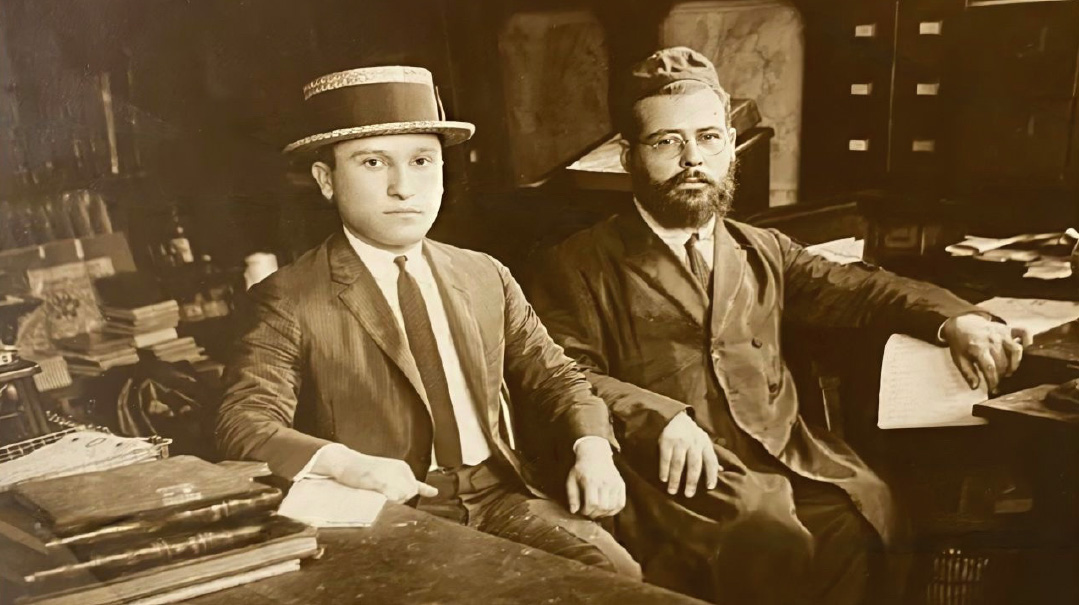
Rav Yehuda Levenberg and Rav Moshe Don Sheinkopf from the early days of the New Haven Yeshivah. The Alter insisted that the students in Slabodka appear neat and well-dressed at all times. He would say, “A hole in the sleeve is a hole in the head. A creased and tattered hat signifies a confused mind.” In the early days of the Slabodka Yeshivah, he even had a tailor on the premises to mend garments
Chapter 3
THE DREAM COMES TO LIFE
The Yeshivah Neighboring Yale
Upon his return from Lakewood, Rav Levenberg immediately began to develop the yeshivah project. He organized a lay committee consisting of local balabatim, and disseminated the following missive via the Yiddish press:
The New Haven Yeshivah will open officially in the month of Elul (August). Our yeshivah will work in close cooperation with rabbis throughout America. Our course of study, aside from Talmud, will include mussar works for the ethical and moral improvement of students. Full opportunity will be given to the students to proceed with their secular studies. Scholarship assistance will be extended according to individual need. Young men interested in enrolling in the New Haven Yeshivah are urged to submit their applications immediately.
The guest list at the Agudath Harabonim included a recent immigrant who was perhaps its youngest participant: a 23-year-old Slabodka student named Rabbi Moshe Don Sheinkopf (1900–1984). Having arrived in the US in December, the as-yet unmarried Rav Moshe Don assumed the pulpit of the Chochmas Adam Anshei Lomza Congregation on the Lower East Side (the Sheinkopfs came from the Lomza region).
Not long after the conference in Lakewood, Rabbi Levenberg announced that Rav Moshe Don was his choice as rosh yeshivah of the proposed institution. A short while later, Rav Sheinkopf married Rivka Seltzer, the daughter of one of the leading members of the Agudath Harabonim, Rav Yehuda Leib Seltzer (1869–1959) of nearby Bridgeport, Connecticut (Rav Seltzer had served as the rav of Patterson, New Jersey while Rav Levenberg was in Jersey City).
Now the yeshivah needed a building. On July 28, 1923, attorney Joseph Kaletsky obtained a charter for the New Haven Yeshivah, and a house at 83 Park Street, directly across the street from Rav Levenberg’s home, was purchased with the help of several local guarantors at the cost of $30,000. The ten-room mansion had formerly housed students from Yale University, and was now repurposed as a yeshivah — complete with a beis medrash, dining hall, and several dormitory rooms. Rav Levenberg’s dreams and hopes were becoming a reality.
The official opening of the New Haven Yeshivah took place on Sunday, August 12, 1923, with the participation of leading rabbanim from New York, New Jersey, and New England. The keynote speaker was the longtime rav of Hartford, Connecticut, Rav Tzemach Hoffenberg (1857–1938). Other attendees included distinguished rabbanim such as Rav Yosef Konvitz (1878-1944), Rav Yisroel Rosenberg (1875-1956), Rav Yitzchok Siegal (d. 1976), and many others.

(Left) Students at the New Haven Yeshivah, including Shmuel Levenberg (bottom) and Moshe Eliyahu Gordon (center); (Right) The mansion at 83 Park Street, which once housed students from Yale, would now be the home of America’s first out-of-town yeshivah
The Outreach Effect
The event also attracted a large attendance of New Haven locals who were impressed by what they saw and heard, especially the voices of authentic Torah study reverberating from the newly gathered student body.
A report in the Bridgeport Telegram on October 25, 1923, claimed, “There are at present 20 students enrolled, many of whom are also studying at Yale University.” This seems to be in addition to local boys who attended the yeshivah for half a day while also enrolled in a local public school.
Three years later, the yeshivah took this a step further when it invited Jewish students at Yale to eat meals and, in some cases, even to reside in the yeshivah’s dormitory. This concept saw limited success, leading the yeshivah to initiate a campaign to purchase another home closer to the university. This residence, Rav Levenberg hoped, could serve as truly Jewish “fraternity” where students could reside in a traditional Jewish environment under the supervision of the yeshivah. Perhaps this was America’s first campus kiruv initiative.
In addition to kiruv efforts at Yale, Rav Levenberg brought the fledgling Young Israel movement to New Haven in 1927. A letter to Dos Yiddishe Tagblatt extolled those efforts:
Several weeks ago, Rabbi Judah Levenberg, chief rabbi of New Haven, assembled about a dozen boys and stressed to them the necessity and significance of an organization that would tend to unite the Jewish youth of New Haven, and implant and disseminate traditional Judaism in and among the Jewish boys of New Haven. Rabbi Levenberg organized the Young Israel right there and then.
Under the leadership of Mr. Nathan Rosen of the Yeshivah of New Haven, the membership has increased by leaps and bounds. Last Saturday, less than two months since the Young Israel was organized, we had an attendance of 80 boys. Isn’t that remarkable?
Rabbi Levenberg was present and in a very inspiring talk expressed his amazement at such a prompt realization of his dreams. The services are held in the beautiful and spacious auditorium of the B’nai Israel Synagogue. They are conducted along purely traditional lines and are beautified by harmonious congregational singing and perfect decorum. We have our own “chazzanim” and “gabbaim” and all the necessary “klei kodesh.”
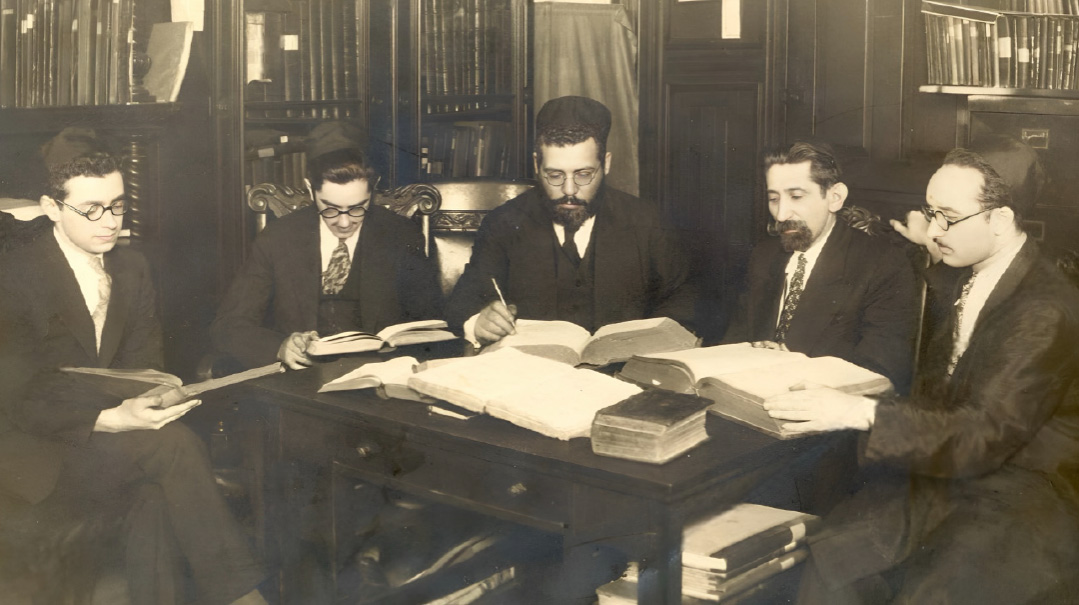
Rav Levenberg in the library of the yeshivah, surrounded by talmidim. First on the right is Elya Moshe Gordon
Reb Yaakov Yosef Herman, Recruiter
The student body of the new yeshivah came from across the Northeast. One of the yeshivah’s best recruiters was Reb Yaakov Yosef Herman (1880-1967). In All for the Boss, his daughter Ruchoma Shain (1914-2013) describes how her father was able to send 14-year-old Shachne Zohn (1910-2012) to New Haven in 1924:
Rabbi Shachne Zohn, a former rosh yeshivah in Torah Vodaath in Brooklyn, New York, and presently rosh yeshivah of a kollel in Yerushalayim, is a product of Papa’s special care. At 13 years of age, he was attending public school on the East Side. After school, his father sent him to the Mordechai Rosenblatt Talmud Torah at 134 Henry Street where he received religious training for an hour and a half.
Mr. Zohn had a little cap business that kept him occupied all week. The few hours on Shabbos which he was able to spare for his son were too few to instill in Shachne the love for Torah learning. His father therefore was concerned about his son’s religious education. He knew Papa and had heard of his deep influence on young boys. He brought Shachne to Papa and placed him under Papa’s guidance. Papa immediately withdrew him from public school and registered him at Yeshiva Rabbi Jacob Joseph.
Shachne joined the group of 45 boys to whom Papa taught Ein Yaakov in English each evening at Tiferes Yerushalayim. A short while later after Shachne began studying at the yeshivah, Papa used his tactful pressure to convince Shachne to go to the New Haven Yeshivah where Nochum Dovid (Herman), Chaim Pinchas Scheinberg, Boruch Kaplan, Reuven Epstein and a few of Papa’s other talmidim were already studying at Papa’s urging.
Ruchoma Shain continues that her Papa did not stop there: he maintained constant contact with Rabbi Levenberg and the other roshei yeshivah regarding the progress of “his boys.” When they returned home for the Yamim Tovim, he inquired into every detail of their lives and learning.
When Shachne had completed four years of study in the New Haven Yeshivah, Reb Yaakov Yosef advised him to continue his Torah studies in Mir, Poland. More than a half-century later, Rav Zohn became emotional in an interview about his New Haven years:
Rav Herman was my first rebbi and also Rav Boruch Kaplan’s first rebbi and Rav (Chaim Pinchas) Scheinberg’s first rebbi. Because he gave us the hashkafah of yiras Shamayim, because in those days, something like over seventy years ago, America didn’t have (European-style) yeshivos…. He was the one that inspired all of us that we should go to New Haven and then we should go to Europe…. He was de Tatte… like Avraham Avinu fahr yenne tzeit. They [his talmidim] were the nucleus of New Haven, and were his best, his best, the top, of New Haven talmidim.
Saved from New York’s Trolleys
Rav Boruch Kaplan (1909-1996), who along with his wife, Rebbetzin Vichna (1913-1986), would eventually revolutionize Bais Yaakov in America, was another one of the boys from the Lower East Side who was sent to New Haven by Rav Yaakov Yosef Herman.
In Rebbetzin Vichna Kaplan — The Founder of the Bais Yaakov Movement in America, Rav Boruch’s son Rabbi Shimon Kaplan quoted his father: “Ehr hat mir arois geshlept fun unter der redder, he [Rabbi Herman] dragged me out from under the wheels [of the trolleys and cars],” a reference to the fate of most of his childhood friends, who were lost to the trials and tribulations of the streets of New York.
Boruch Kaplan arrived in New Haven in June, shortly before the yeshivah broke for the Av summer intersession. Undeterred, he worked day and night to catch up to the students who had arrived the previous September. It was hardly a coincidence that the student whom Rav Zohn described as the best bochur ever produced by New Haven would be brought up to speed by a Torah genius who had once been known as (along with Rav Aharon Kotler) the top student in Slabodka, Rav Yaakov Safsal, best known as the Vishker Illui.
A humble giant who eschewed the limelight, Rav Yaakov devoted endless hours to honing the skills of the boy from the Lower East Side who never seemed to run out of energy or thirst for additional Torah knowledge. When bein hazmanim arrived, the pair continued learning in the empty beis medrash.
Late at night, when the lights went out, Boruch Kaplan could be seen learning from the glow of the pilot light of the oven. The yeshivah’s cook, who happened to hail from the city of Pinsk, took pride in his landsman and even provided him with meals during the monthlong intersession.
By the time the rest of the students returned in Elul, Boruch Kaplan had morphed from a boy who could not learn a single blatt Gemara, to a master of all of Maseches Gittin with Tosafos.
To Create Menschen
Even as his young charges thrived in their Torah study, Rav Levenberg reminded them that without mussar, their learning could all be for naught.
The story is told of a man who questioned Rav Yisrael Salanter, “Rebbi, I have only fifteen minutes a day to learn Torah. What should I study?”
Rav Yisrael replied immediately, “Learn mussar.”
“Why mussar?” asked the man.
“Because,” responded Rav Yisrael, “if you start learning mussar, you’ll realize that you have more than fifteen minutes a day to learn!”
Asked the difference between him and the Alter, the Chofetz Chaim reportedly said with his trademark humility, “I write books, he creates menschen [men].” The same could be said for Rav Levenberg, who sacrificed everything to mold menschen in a place where everyone said it was impossible.
One former student of the yeshivah, Rabbi Abraham Bick (1913–1990), wrote a glowing account of the atmosphere on Shabbos afternoons, when Rabbi Levenberg presented his popular mussar shmuessen:
The writer of these lines studied a considerable time in the New Haven Yeshivah, and the atmosphere of late Shabbat afternoons toward twilight is still fresh in my memory. Rabbi Levenberg, deep in thought, would enter the four walls of the cottage on Park Street where the students would be waiting silently at their study lecterns for his discourse. Rabbi Levenberg would break out in a niggun, and in the last play of light and shadow, he would commence his mussar discourse.
In his 2004 Jewish Observer piece entitled “Torah Shines Forth… From New Haven to Cleveland,” the author Rabbi Dr. Ari Z. Zivotofsky writes:
When I asked Rabbi Chaim Pinchas Scheinberg, venerable rosh yeshivah of Torah Ore in Yerushalayim’s Mattersdorf, for his recollections about the yeshivah, he pointed out the obvious — it was a VERY long time ago, and it is difficult to remember details. But when I mentioned Rabbi Levenberg, a smile crept across his face as he related that Rabbi Levenberg was a masterful speaker. And then Rabbi Scheinberg began humming as he told his son and me how Rabbi Levenberg would sermonize in a singsong manner that captivated his audience. He seemed to stare inside his mind and dust off old internal pictures as he told us that to this day, he can visualize Rabbi Levenberg standing at the shtender, giving one of his masterfully delivered derashos.
Of Lithuanian Caliber
In early December 1923, Rav Eliezer Silver arrived from Harrisburg as a delegated examiner of the yeshivah’s progress for the Agudath Harabonim. On December 7, 1923, Dos Yiddishe Tagblatt of New York shared Rav Leizer’s report:
I wish to express my joy and pleasure at having visited with the heads of the New Haven Yeshivah. I saw far greater achievement than I had expected. I found learned young men who are completely devoted to the study of the Torah. When I shared with them my shiur (which lasted four hours!), I was astounded by their excellent response. They demonstrated sensibility, logic, and a deep grasp.
I listened to the shiurim of the faculty, and they were of a caliber to be heard in Lithuanian yeshivos. I was moved by a mussar discourse that I heard [from Rav Levenberg]. As of now, there are twenty advanced students enrolled and another twenty of lesser background. There is orderliness in this institution.
I have every reason to believe that the New Haven Yeshivah, under the guidance of its dedicated rabbis, will indeed flourish. May its reputation grow far beyond New Haven’s confines.
A New York journalist, Shimshon Erdberg (1891–1962), who covered Rav Leizer Silver’s visit, reported his personal observations in detail:
The students rise at seven and hold morning prayers. At eight thirty they have breakfast. From nine to twelve, they study and then break for an hour’s lunch. At one o’clock they conduct the Minchah prayers, and thereafter, until six, they continue with their studies. From six to seven, they conduct the “mussar session,” after which they proceed to Maariv prayers. Their English studies are then conducted (those who were still in high school) after a quick dinner, until ten o’clock.
In the lower department, which consists of students from New Haven, they study beginner’s Talmud, Tanach, and the Hebrew language. They are involved in these studies from four to seven thirty and attend evening high school sessions. There is a remarkable spirit among the student body. What a beautiful scene it was to behold!
Rabbi Silver had good reason to be impressed! I am delighted by New Haven’s achievement and hope that other American cities will emulate its efforts. Blessed be the New Haven laity who have helped to establish this yeshivah. Rabbis Levenberg and Sheinkopf are truly remarkable men; the students are treated by them in a most fatherly manner.
Though its initial enrollment was small, the yeshivah steadily gained popularity. Writing in late August of 1924 as the yeshivah began its second year, Rav Sheinkopf informed his acquaintance Tzvi Chaim (Harry) Epstein (1903-2003) (then studying under his uncle Rav Moshe Mordechai in Slabodka) that “students from all over the country are streaming to the yeshivah. However, we are regrettably unable to accept all who apply, owing to the [financial situation], which is extremely limited.”
Living Examples
The staff of the New Haven Yeshivah was graced by several eminent Torah scholars who served as a living example to the American-born students, demonstrating the heights a true talmid chacham could reach.
In the summer of 1926 Rav Sheinkopf was hired by the brand-new Mesivta division of Yeshiva Torah Vodaath, a move heralded by a rare letter from the Alter of Slabodka himself to Dos Yiddishe Licht. This exemplified the spirit of Slabodka, which aimed to exert influence over Torah institutions and press its mussar ideals, even at the expense of its own institutions. A couple of years later, when he was appointed rav of nearby Waterbury, Connecticut, Rav Sheinkopf rejoined the New Haven Yeshivah, delivering a shiur several times a week.
Sometime in late 1924, Rav Levenberg approached his student Sender Linchner with an urgent fundraising mission: Rav Sheftel Kramer, a brother-in-law of Rav Moshe Mordechai Epstein, had agreed to join the faculty of the yeshivah, and funds were needed to pay for his passage. By then, Rav Sheftel was a familiar name in the yeshivah world, particularly in the Slabodka orbit.
Born in 1875 in Lygumai (present day Lithuania), he studied in Telz and Slabodka and was considered one of the illuyim of his era. During his time in Slabodka, Rav Sheftel developed a reputation as a strong defender of mussar (particularly during the tumultuous period of 1897 in Kovno and Slabodka), and the Alter selected him to join an elite group of students who traveled to Kelm, studying under that institution’s famous Alter.
In 1902, Rav Sheftel married Devorah Frank (1878–1966) of Alexot, thereby joining one of the most prestigious families in the mussar yeshivah world: Devorah’s sisters were already married to, respectively, Rav Isser Zalman Meltzer (1870-1953), Rav Moshe Mordechai Epstein, and Rav Baruch Horowitz (1870-1936) (her late father, Rav Shraga Feivel (1843-1886), had been among the most dedicated financial supporters of the mussar yeshivos).
Several years later, in 1907, Rav Sheftel joined Rav Isser Zalman in Slutzk, serving as the menahel ruchani of the yeshivah. At a time when the Haskalah attempted (with some success) to make inroads into the yeshivos of Eastern Europe, the new Mashgiach developed a reputation as a zealous guardian against any such hostile winds.
Rav Sheftel served in Slutzk until the upheavals of World War I landed him and his young family in Kharkiv, where he used his experience and talents to set up a yeshivah there, serving the young men among his fellow refugees.
With the conclusion of the war (and the communist takeover of Russia, where Slutzk was situated), the Kramers found their way back to Slabodka, where Rav Sheftel tried his hand at a business endeavor to support his family. The Alter, however, insisted that he share from his wellsprings of Torah and yiras Shamayim with the local yeshivah students, and Rav Sheftel began delivering private shiurim and sichos in his home. He was also active in the local Tiferes Bochurim, a learning program for young men in the workforce.
(According to one report, during this interwar period, when the border between Lithuania and Poland was sealed — greatly reducing the Alter’s impact on the Eastern European yeshivos of Poland — a plan was hatched to sneak a group of students led by Rav Sheftel into Poland, to infiltrate the yeshivah in Volozhin. Ultimately however, this did not materialize.)
“Get Close to Reb Sheftel”
By the time Rav Levenberg’s invitation to join the New Haven Yeshivah arrived, Rav Sheftel was struggling to make ends meet. Adding to the financial strain was the marriage, in early 1924, of his eldest daughter Feiga to one of the bright stars of Slabodka: a young illui from Dolhinov named Yaakov Yitzchak Ruderman (1900-1987).
Rav Sheftel Kramer traveled to the United States, alone, in November 1924 (his two teenaged unmarried daughters would join him in the summer of 1926, while his wife and two youngest daughters would not arrive until another year had passed), and officially joined the yeshivah several months later, in early 1925.
It took some time for the American-born students to adjust to Rav Sheftel’s shiurim and shmuessen. Reb Yitzchak Ber Gordon (1879–1957) of Richmond Hill, New York, wrote to his son Eliyahu Moshe who would go on to learn in the great Torah centers of Europe, encouraging him to properly utilize the living sefer Torah in New Haven’s midst:
Reb Sheftel is a precious beloved Jew, of great character. He is a doer of good deeds. All these in addition to being a great learned Torah scholar. He is bright and clever. He really understands you boys very well. It is therefore in your interest not only to accept his influence when he gives it but you must search him out, draw Torah from him, learn from him as much as you can. Exploit Reb Sheftel in all ways so long as you are near to him.
Therefore, I advise you, my son, to get closer to him. Show him that you are interested in being close to him, to learn from him; “encourage him to it.” Go so far as to ask him to give you a shiur in Yoreh Dei’ah. Request his advice in general subjects and certainly in spiritual matters. You will gain from every detail that you will learn from him. If you do these things, you will get closer to the goals you set for yourself.
Eventually, the talmidim acclimated to Rav Sheftel and became close students, who relished his daily shiur. Still, it was a different relationship from the one they shared with Rav Levenberg, who by then spoke a good English and even drove his own car around town, unusual for a European-born Rav. (Although one New Haven native humorously recalled that Rav Levenberg was, as he bluntly put it, “a terrible driver. After yet another near accident he would say, ‘Had I put another coat of paint on my car I would have crashed’ — that is how close he got to crashing.”)
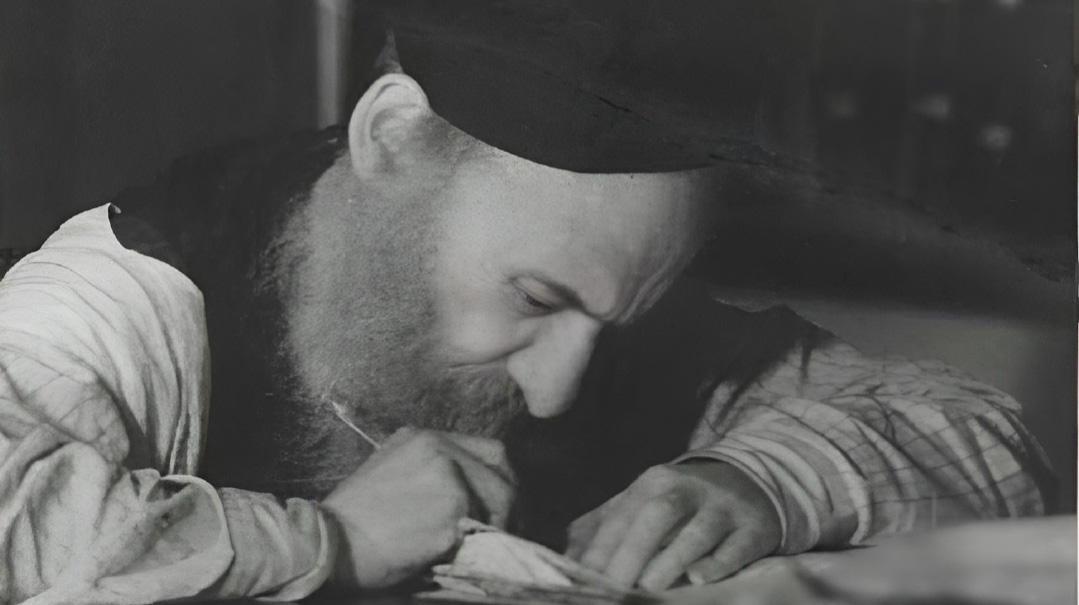
The Vishker Illui
Rav Yaakov Dov Safsal (1888–1968) was born in Dvinsk, Latvia, to Rav Refoel Minkin, a shochet who served in both Dvinsk and the neighboring village of Vishka. Due to financial struggles, Rav Refoel traveled to the United States in hopes of earning a better living, leaving young Yaakov to be raised by his uncles, Rav Baruch Zev Minkin of Grieva and Rav Dovid Minkin of Dubines.
The boy’s genius was apparent from a tender age. In the approbation of Rav Yosef Eliyahu Henkin to Part I of the work Divrei Yaakov, he writes, “It is difficult to find an illui of that stature, for in addition to other things, he was able to learn 50 or 60 pages of Gemara in one hour. I heard directly from Rav Leizer Silver, who in turn heard directly from Rav Chaim Ozer, who was an expert in the world of the illuyim, as they would all come to talk to him, that he (Rav Eliezer Silver) asked Rav Chaim Ozer to name the greatest illui in the yeshivah world. Rav Chaim Ozer thought for a moment and said that Rav Yaakov Safsal is without a doubt the greatest illui among the illuyim.”
Growing up near Dvinsk, the Vishker Illui was a regular sight in the home of both Rav Meir Simcha (the Ohr Sameach) and Rav Yosef Rosen, the Rogatchover Gaon. He studied under the Chofetz Chaim in Radin, who would invite him for Shabbos and delight in his recitations of Gemara with Rashi and Tosafos by heart; Rav Refoel Shapiro in Volozhin; Rav Chaim Soloveitchik in Brisk; Rav Chaim Ozer in Vilna; Rav Isser Zalman Meltzer in Slutzk; Rav Eliezer Gordon and Rav Chaim Rabinowitz in Telz; Rav Eliyahu Baruch Kamai in Mir; Rav Baruch Ber Leibowitz and Rav Moshe Mordechai Epstein in Slabodka; and Rav Yitzchok Yaakov Rabinowitz in Ponevezh. In eight years, he returned home only once.
The Vishker Illui is quoted numerous times by Rav Baruch Ber in his sefer Birchas Shmuel. In Kamenitz, he would complete pages of Gemara in mere minutes, retaining it all in his phenomenal memory. The other bochurim would marvel at his ability to ace the “pin test,” a challenge that involved sticking a needle through the pages of a Gemara, where he proved he could identify the pierced word on any page, even 100 dapim away.
A Slabodka contemporary described Rav Yaakov’s unique intensity: “The Vishker fellow, then a young man of 15 or 16 years, was known for his mastery of Torah. At nine years old, when he came to the Slabodka Yeshivah, he could already explain Bava Kamma, Bava Metzia, and Bava Basra — all three tractates by heart, summarizing the Gemara with Rashi…. He would then sit for hours on end, locked in position with his fist on his forehead, eyes closed, and it seemed as if he was dreaming. But only someone with a particularly sharp insight could see that something was churning inside him, a storm was brewing within. This is how the Vishker would leaf through the entire Shas in his mind, soaring through it like an eagle over the sea of the Talmud….”
In 1909, Rav Yaakov immigrated to America, where his family had settled, but soon after arriving, he decided to return to his treasured yeshivos back in Europe. He was arrested by the Germans during World War I, but freed with the help of Rav Chaim Ozer. In 1921, he returned to the US, joining the faculty of New Haven Yeshivah under the leadership of his friend Rav Yehuda Levenberg.

At the bris of Zechariah Schneider in the Bronx in 1962. The Zeide, Rav Moshe Schneider (left) and the sandek, the Vishker Illui
Tragedy struck in 1925 when his wife, Leah (née Greene), a Lithuanian-born New Haven resident, passed away shortly after giving birth. The bereaved Rav Yaakov moved to Colchester, Connecticut, serving as rav and teaching children in the farming community before relocating to New York around 1930, where he remained for the rest of his life.
In 1931, Reb Yaakov Yosef Herman and his wife, who regularly hosted him at their home, suggested a shidduch: Nechama Garfinkel, who had come to New York from Minsk.
In New York, the Vishker Illui held no official position but was revered throughout the Torah world. Torah scholars who wished to speak to him knew to find him at a unique institution, Agudas Anshei Maamad U’beis Vaad Lachachomim on the Lower East Side. When the Mir Yeshiva arrived from Shanghai after the war, Torah giants like Rav Nochum Partzovitz would come speak with him for hours.
In the summers, he could be seen writing chiddushim at lightning speed while riding the subway to Far Rockaway, where family members resided. He insisted on standing during those train rides, due to concerns of shatnez in the seats.
His uncompromising standards were legendary. Once, upon discovering that the rabbi who had offered him a ride presided over a shul lacking a mechitzah, he jumped out of the moving car. He was so attached to Torah, that on Tishah B’Av, he would hold a rubber shoe all day as a reminder not to learn.
When Rav Shlomo Heiman fell ill, he petitioned the Vishker Illui to pray for him. Additionally, when Rav Reuven Grozovsky’s wife, the daughter of Rav Boruch Ber, fell ill, he sent a messenger to the Illui with the message that “the Rebbe’s daughter is sick.”
The Vishker Illui loved talking in learning with the local yeshivah students, often traveling for hours by train to answer a question a bochur posed to him. When Rav Mordechai Elefant of the Itri Yeshiva was a student, he traveled together with his rebbi, Rav Leib Malin, to the Lower East Side to purchase arba minim. Upon being seen by Rav Yaakov, the latter walked over to him, and without any sort of greeting, asked him a question of the Minchas Chinuch and abruptly left. One year later, Rav Mordechai returned to the East Side with Rav Leib, and again Rav Yaakov came over to him and, again without any introduction, said “di teretz is azei — the answer is like this….”
In his memoir, Rabbi Marvin Hier recalls his encounters with the Illui while he was a student at RJJ:
Whenever the yeshivah’s main study hall was crowded, I walked across the street to the small Agudas Anshei Maamad shul, where Reb Yaakov sat and learned. Then in his late seventies, Reb Yaakov was a diminutive man, hunched and thin. But his mind was expansive. My yeshivah friends and I would often test Reb Yaakov’s memory by pretending to have forgotten a Talmudic source. Each time, completely unprepared, he precisely quoted the passage we were referencing, as if he had studied it the day before.
Taking advantage of the special relationship I developed with Rav Safsal, I decided to test the widely held belief that Reb Yaakov concentrated his studies on the early Talmudic commentaries, and ignored the later ones. I selected a question posed by one of the great late commentators, and presented it, as if my own, to Reb Yaakov.
He quickly digested the question, and began pacing the beis medrash, deep in concentration. After several minutes, he walked toward me and declared, “Write your address on a piece of paper. When I have time, I will send you an answer.” For the next ten years, Reb Yaakov sent me dozens of letters in response to my question.
At his levayah in the summer of 1968, Rav Moshe Feinstein delivered a hesped that perfectly summed up who the Vishker Illui was:
There are two types of gedolei Yisrael: there are those who teach thousands, write seforim that everyone studies in depth, which light up the world, and their funerals are attended by thousands. But there are other gedolim that no one knows about, as they have no official position and they and their Torah are hidden in a corner, despite the fact that they and the Torah are one.”
Asked Rav Moshe,
“Which of these two kinds of gedolim are beloved more by Hashem? The pasuk says in Yeshayahu (66: 2) ‘to this man I will look, he that is poor and of a contrite spirit, and trembles at my word.’ This refers, of course, not to someone who is poor financially or poor in his mental capabilities; rather it refers to a gadol b’Yisrael who learns constantly and yet does not merit to teach others for he has no official position, he just sits in the ‘daled amos shel halachah.’ This is the one is who is beloved by HaKadosh Baruch Hu. Rav Yaakov Safsal is the one beloved by Hashem.”
Some of Rav Yaakov’s chiddushim were published posthumously by his son Rav Yosef Shlomo in the three-volume Divrei Yaakov, but his legacy lies in the model he set of a gadol whose very essence was Torah, with no need for prestige or acclaim. His entire being proclaimed, “Ashrei mi she’amalo baTorah — fortunate is the one whose toil is in Torah alone.”
Reb Shraga Feivel: Admirer and Ally
In 1926, the New Haven Yeshivah served as a template for another institution (then in a formative stage), when an elementary school principal from Brooklyn named Reb Shraga Feivel Mendlowitz took a group of students to New Haven on a Lag B’Omer trip, with the goal of demonstrating to them what an American yeshivah could, and should, be.
(One of the talmidim I then studying in New Haven was Moshe Mintz, who had been a student of Reb Shraga Feivel during his tenure in Scranton. Moshe would later marry Rav Levenberg’s daughter Brocha. In a nice bit of symmetry, one of Rav Levenberg’s students, Reb Sender Linchner, would marry Reb Shraga Feivel’s daughter Batsheva.)
The link between Rav Levenberg and Reb Shraga Feivel was further bolstered when Reb Shraga Feivel took the bold initiative of opening Mesivta Torah Vodaath that very September. Along with the high school (to which Rav Levenberg sent his 12-year-old son, Shmuel), he inaugurated a beis medrash program, consisting of 11 students sent from New Haven (including Charles Batt). The daily shiur was delivered during the initial year by none other than the now married Rav Moshe Don Sheinkopf, who had, of course, cut his teeth teaching American young men under Rav Levenberg.
“Rabbi Levenberg’s dream of many years has finally come to fruition,” stated an editorial in Reb Shraga Feivel’s Dos Yiddishe Licht. “New Haven has merited to have a corner of Torah built on the principles of the Slabodka Yeshivah: Torah, mussar, fear of Heaven, and serving G-d with great fire and enthusiasm, just as we were accustomed to seeing in der alte heim…. It will surely become a model for other places in this country where they will hopefully establish more ‘tents of Torah’ such as this.”
While Torah Vodaath would go on to play a critical role in the spread of Torah in the United States, rightfully earning its reputation as the mother of American yeshivos, the New Haven Yeshivah played an important role in the former’s development, serving as a proof of concept and supplying both students and faculty, a role the Alter of Slabodka pioneered back in Europe when he sent his best and brightest students to found or supplement yeshivos such as Slutzk, Mir, Telz, Maltch, as well as several others.
On a more personal level, Reb Shraga Feivel credited Rav Levenberg for opening up his eyes to the world of mussar, specifically Derech Hashem and Mesillas Yesharim, seforim that were not commonly learned in the Hungarian yeshivos where Reb Shraga Feivel had studied.
Notable in New Haven
Rabbi Yehoshua Mordechai (Charles) Batt
1905–1978
Born in Connecticut, he was one of the yeshivah’s finest students, he spoke, representing the student body, at the Yeshivah’s first graduation / Chag Hasemicha in May of 1925. After moving on to Torah Vodaath, Charles Batt was a chinuch pioneer for over half a century in Hartford, where he was among the founders of the local day school. He also served for many years as the rabbi of Young Israel of Greater Hartford. As a board member of Torah Umesorah, he shared a close relationship with gedolim such as Rav Moshe Feinstein, Rav Yaakov Yitzchok Ruderman, and the Lubavitcher Rebbe, with whom he consulted on a regular basis on a myriad of important matters.
Reb Alexander (Sender) Linchner
1908–1997
Born in New York, he was a close talmid and eventual son-in-law of Reb Shraga Feivel Mendlowitz. Reb Sender was one of a handful of Americans to study at the Radin yeshivah of the Chofetz Chaim. Upon his return to America, he served as a popular principal of Mesivta Torah Vodaath, while also channeling his love for Eretz Yisrael into the founding of Boys Town Jerusalem. Established in 1948 to provide a home and education for young immigrants, Boys Town has gone on to become one of the country’s largest and most respected educational institutions, still thriving more than 70 years later.
Rabbi Aharon Paperman
1914–2002
Born in Baltimore, he was educated in the local Talmudical Academy, the first Jewish Day School outside of NYC. He later traveled to study at RIETS before moving on to New Haven. When the yeshivah moved to Cleveland, he followed in the path of Rav Mordechai Gifter to Telz in Lithuania, where the two became close friends. After nearly seven years in Europe, he returned with several prestigious semichahs and married Chaya Schwartz, the daughter of Talmudical Academy’s founder, Rav Avraham Nachman Schwartz. He served in the rabbinate for a few years until America’s entry into World War II, when he was advised by the Telzer roshei yeshivah to join the US Army as a chaplain, where his years of service would become the stuff of legends.
Following the war, Rav Shraga Feivel Mendlowitz helped his former city of Scranton open a Jewish Day School and encouraged Rabbi Paperman to join as its principal. After six years there, he heeded the wishes of the Telzer roshei yeshivah to come to Cleveland and join the yeshivah’s staff as Executive Director, helping Telz build itself up for the next 15 years. The last decades of his life were spent as a fundraiser for Chinuch Atzmai. The Papermans moved to Eretz Yisrael, where they were among the founding residents of Telshe-Stone, and Reb Aharon enjoyed his final years learning.
Rabbi Menachem Tzvi Eichenstein
1910–1981
He was born in Strzyżów, Poland, to a family with a rich chassidic lineage: his father, Rav Yehoshua Heschel (1882-1940), was a direct descendant of a long line of Ziditchov Rebbeim, stretching to the late 1700s. In 1924, the family moved to Chicago. Aside from the New Haven Yeshivah, he traveled to learn in the great chassidic European yeshivos of the 1930s, including Pressburg and Chachmei Lublin. While in Lublin, he married Rikel Sarah (Renee) Twersky (d. 2002), daughter Rav Moshe Mordechai Twersky (1877-1943) of Trisk Lublin.
In 1940, Rav Eichenstein was invited to St. Louis by Rav Chaim Fishel Epstein (1874-1942). Two years later, he was appointed to succeed him as Chief Rabbi of St. Louis, a title he proudly held for the next four decades.
Rabbi Nosson Nota Zuber
1903–1988
Born in Shchadryn (present-day Belarus), he emigrated to the United States in July of 1923, and several months later joined the first group of students that formed the nucleus of the New Haven Yeshivah. He was among the first two students to receive semichah from the yeshivah in May of 1925, and the following year assumed the pulpit of Congregation Beth David in Roselle, New Jersey, a position he filled for the next half century. Rav Zuber authored the works Zichron Menachem (1971) and Divrei Nosson (1977).
Rav Chaim Pinchas Scheinberg
1910–2012
Born in Ostrov, Poland, he arrived in the United States as a 9-year-old, and after a short stint in public school, he was enrolled at RJJ. At that time the legendary Reb Yaakov Yosef Herman encouraged him to transfer to the yeshivah in New Haven, where his son Nochum Dovid and other Lower East Siders were seeing success. It was in New Haven where he was mesayem Shas for the first time at the age of 16. Two years later, he married Bessie Herman and would go on to become one of the great roshei yeshivah of his time.
Rav Shalom Shachne Zohn
1910–2012
Born in a small town near Medzhybizh in Ukraine, his family moved to New York when he was nine years old. His four years in New Haven were followed by close to a decade spent in Europe studying in Mir and Kaminetz and basking in the presence of the Chofetz Chaim. He was among the founders of the White Plains Kollel, which was the predecessor of Beis Medrash Govoha in Lakewood. He later served as a rosh mesivta in Torah Vodaath before moving to Eretz Yisrael in 1970. In Yerushalayim he founded a Kodshim kollel.
Rabbi Eliyahu Moshe Gordon
1908–1979
The first of three Queens, NY brothers to learn in the great Torah centers of Mir and Kamenitz, he later married Chava Ralbag, the daughter of Rav Aryeh Leib Ralbag, chief rabbi of Coney Island. The Gordons headed for Annapolis, Virginia where a rabbinic position awaited, and continued with successive pulpits in NYC. He also accepted an offer from Rav Yitzchok Hutner to become a maggid shiur in Mesivta Rabbeinu Chaim Berlin, where the American born rebbi influenced many talmidim, among them a young Rabbi Shlomo Freifeld — who credited Rabbi Gordon for giving him a love for Torah and Yiddishkeit as a 14-year-old boy.
Reb Boruch Kaplan
1911–1996
He was known as the “Masmid of New Haven” where he recalled studying through the night by the light of the gas jet in the kitchen, “until we heard the horses delivering the milk before dawn.” He subsequently studied in the Slabodka Yeshivah in Chevron and in yeshivos of Eastern Europe. His marriage to Sarah Schenirer’s disciple Vichna Eisen in 1937 would shape his life destiny, as they set out to build Bais Yaakov in the United States. Soon after, he left his maggid shiur position in Torah Vodaath to knock on doors to recruit students and solicit funds for the fledgling school. He went on to become principal alongside Rebbetzin Vichna, where he proudly carried the rare distinction of being one of the only rabbis in Jewish history to live in the shadow of his illustrious wife.
Rabbi Yaakov Cohen
1908–1993
Yaakov (Jacob) Cohen was the son of Rabbi Leber Cohen, a New York rabbi and an expert in the fields of kashrus and gitten. He followed his time in New Haven with three years of diligent study in Chevron, where he narrowly survived the bloody massacre. He reunited with his friends from New Haven in the Mir, where he received semichah from Rav Eliezer Yehuda Finkel and Rav Avraham Tzvi Kamai. Returning to America, he spent the next 50 years as a rav in Spring Valley. In 1946 he led a delegation of Mir alumni to San Francisco, to welcome a group of refugee students of the Mirrer Yeshivah in Shanghai.
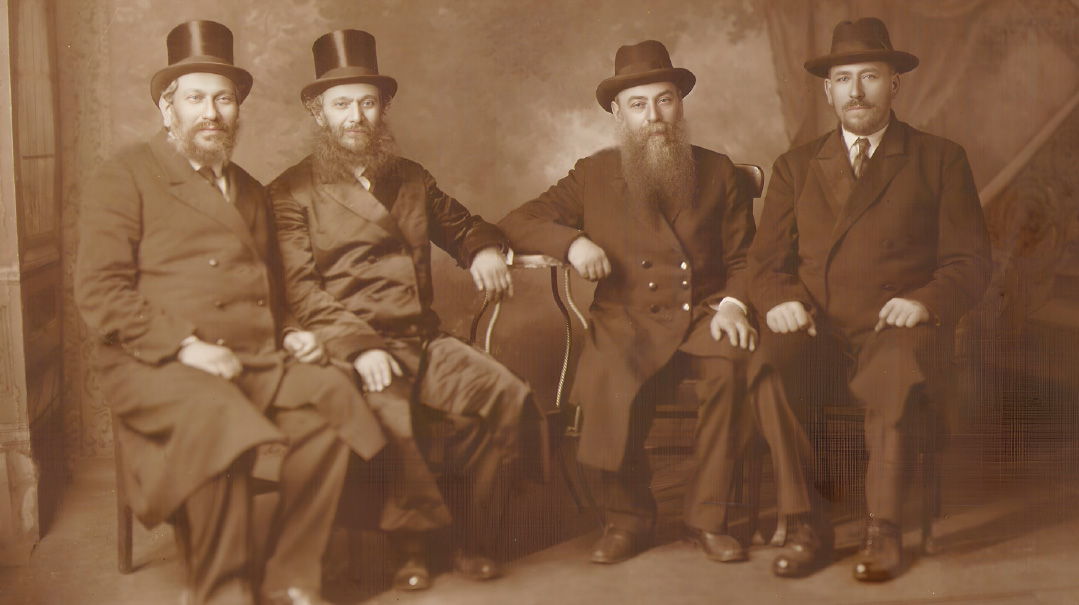
(L-R) Rav Avraham Yitzchok Shuchatowitz (1870-1946), Rav Moshe Mordechai Epstein, Rav Sheftel Kramer and Reb Tzvi Pesach Frank (1874-1950) of New York (a brother of Rebbetzins Menucha Epstein and Devorah Kramer). This photo was likely taken in 1927 at the wedding of Rav Sheftel’s daughter Chaya Pesha (1908-1972) to Rav Schuchatowitz’s son Mordechai (1903-1946), the future Rav of Edgemere and founder of HILI
Chapter 4
STORMY WATERS
Growing Pains
AS founder and leader of the yeshivah, Rav Levenberg had to shoulder the financial burden as well. This proved to be a grueling endeavor. Even with the financial commitments he had collected from locals prior to opening te yeshivah, he constantly struggled to keep its finances stable.
The yeshivah’s location played a factor in this struggle as well. With RIETS in NYC struggling financially in a city with 1.5 million Jews, it was no surprise that Rav Levenberg struggled to balance his budget in a city with just 20,000 Jews. He would often have to forgo weekends at the yeshivah and travel instead to New England cities with large Jewish populations where he could raise funds. Boston, Dorchester, and nearby Bridgeport, Norwalk, and Colchester were regular stops.
In Yonoson Rosenblum’s biography, Reb Shraga Feivel, Reb Sender Linchner shared a quote he heard from Rav Levenberg that especially moved him: “Do you know what mesirus nefesh is? You probably think of mesirus nefesh as being burned at the stake to sanctify Hashem’s Name. But that is mesirus haguf (sacrifice of the body). I could have stayed in Slabodka and spent my life going through Shas many times. Instead, I came to America and spent my days collecting tomatoes from the Jewish farmers around New Haven so the boys would have something to eat. That is mesirus nefesh!”
Rav Levenberg paid a substantial personal price for his dedication. Beginning early on in his New Haven tenure, he was hospitalized several times for what was simply termed “exhaustion.”
In 1924, when his former rosh yeshivah Rav Moshe Mordechai Epstein arrived in America along with Rav Avraham Yitzchok Hakohen Kook (1865-1935) and the Dvar Avraham of Kovno to raise funds for the war-torn yeshivos of Europe and Palestine, Rav Levenberg was lying ill in the hospital. Disregarding medical advice, he returned to yeshivah for the momentous visit of his venerated rosh yeshivah. On Tuesday, March 11, 1924, Rav Moshe Mordechai delivered an intricate shiur on the sugya of Huchlat Hashor (Bava Kamma 33a; see Levush Mordechai, Bava Kamma II:8).
In an interview later that week with Dos Yiddishe Tagblatt, Rav Moshe Mordechai heaped praise upon his dear student like a proud father:
“I went to New Haven to visit the yeshivah that was established by my honored friend, the famous gaon, the treasure trove of yiras Shamayim, our teacher, Rabbi Yehudah Heschel Levenberg shlita. I thank Hashem that he [Rav Levenberg] has not forsaken his people and that he has undertaken to ensure that Torah is not forgotten among Klal Yisrael. I was amazed to see here, in America, a heiliger yeshivah filled with gold and diamonds. I saw the talmidim of the yeshivah — young men, great in Torah, learning diligently, devoted with the totality of their souls to growing higher and higher in understanding Torah.”
Even though he was in America on his own fundraising mission, he urged readers to support his beleaguered student’s yeshivah. “I would urge my rabbinic colleagues and Jewish laymen to offer their fullest support to the New Haven Yeshivah,” he told the Tagblatt.
Stale Bread and Scraps of Meat
But Rav Levenberg continued to struggle. Meals at the yeshivah were meager, often consisting of whatever food supplies the bochurim could collect from local store owners.
Rav Yaakov Fensterheim, a maggid shiur in Yeshiva Bais Moshe of Scranton, described his father Reb Moshe’s experiences in New Haven: “My father came from an affluent family and found it challenging to make the rounds early in the morning going to the Jewish stores in New Haven to collect food for the bochurim.”
It wasn’t just the students who struggled. In a letter from September of 1926, Rav Sheftel Kramer confided to the aforementioned Rabbi Yitzchak Ber Gordon that he hadn’t received his salary for two months, and was seriously weighing whether to leave the yeshivah altogether.
Things got even worse as the years went on. In an interview with Professor William Helmreich, Baltimore-born Rabbi Zalman Skaist (1911-1985), who would later marry Rav Sheftel’s daughter Leah, described the difficulties that the yeshivah faced soon after his arrival in 1928:
“It was just like a European yeshivah. You learned all day and night and the community helped us exist. But when the Great Depression hit, things got very tough. Every morning a fellow in the yeshivah would get up at 6:30 a.m. and go from butcher to butcher with a paper bag. And they would throw in scraps of meat. Some of the bakers gave us old bread and every Friday before Shabbos [Sabbath] some women would come around and donate a couple of chickens. I remember one Rosh Hashanah when all we had was a little challah [bread] and two tomatoes and that was it.”
Being the first “European-style” yeshivah in America had its advantages. When the mostly-American reared students grew unhappy in 1925 with the food arrangements made by the yeshivah’s sisterhood, they penned a letter of protest. It was a move reminiscent of (but not quite as sharp as) the strikes that were held in European yeshivos such as Volozhin, Slaboda, Radin, Telz (and even New York’s Etz Chaim) over various student grievances, including the lack of adequate foodstuffs:
Dear Parents’ Association!
Knowing that you have undertaken to work for the welfare of your sons and all the students of the Holy Yeshivah who are studying here, we hereby deem it necessary to inform you about the current conditions: the cook has little understanding of what cleanliness is and the food is lousy. Although they try to convince us that the quality is sufficient, we know (otherwise) because we and no one else are the ones who are eating the food and experiencing discomfort, and we feel that the situation should be improved immediately. The meat we are served is almost a “poison of death” for our stomachs and many boys need to take medication. A meeting of all the yeshivah boys was convened and we all protested against the kitchen staff and all those who aren’t understanding of our situation.
The letter was signed by the students, including several who would later become prominent rabbinical figures. For Rav Levenberg it was yet another sign that perhaps New Haven was not going to remain the yeshivah’s long-term home.
Still, he remained committed to the project. At some point, Rav Levenberg was offered the position of mashgiach ruchani in RIETS by Rabbi Dr. Bernard Revel (1885-1940), himself a mussar enthusiast — but he declined the offer. (Ironically, the position was later filled by another Slabodka talmid, Rav Yaakov Moshe Lessin (1889-1975), who spent a short time serving as mashgiach in New Haven upon the recommendation of Rav Moshe Mordechai Epstein at the end of 1924 before returning to Europe.)
Rav Levenberg was also offered a position in Yeshivas Rabbeinu Chaim Berlin, but turned that down as well. He preferred to invest in his own yeshivah, no matter how difficult it would be. He was buoyed by the fact that despite its constant struggle for financial sustainability, the yeshivah continued to flourish and grow.
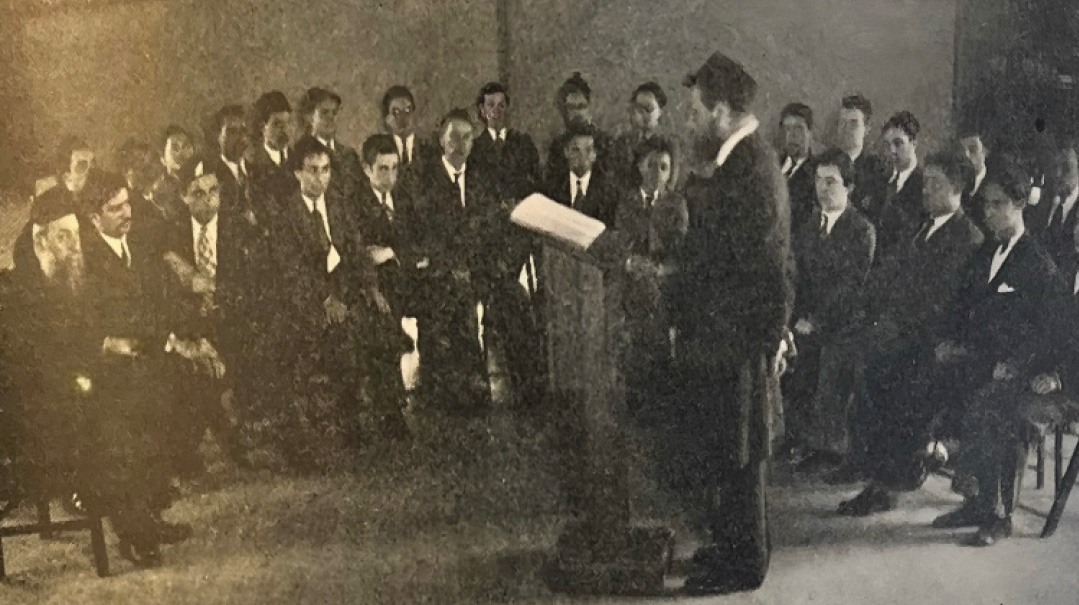
Slabodka in America
After just two years in New Haven, it seemed that the yeshivah’s tenure in the city had run its course. Reports surfaced that the burgeoning Jewish population in the former summer resort of Far Rockaway, New York had put together a fund of $300,000 to bring the New Haven Yeshivah there.
The plan was for the yeshivah to take over the 150-room Kensington Garden Hotel on Mott Avenue. This kosher hotel was popular among Orthodox Jews because its proprietor was Reb Yaakov Andron, a brother-in-law of Reb Yaakov Yosef Herman and a Torah scholar himself who could boast of semichah from the great gaon Rav Chaim Heller (1878-1960), and thus was the host to many important rabbinic conventions.
When the New Haven community was given word of this proposal, however, it pushed back and promised to ensure the yeshivah the necessary support. For a short while, it seems that the yeshivah’s finances were solidified and it grew in both size and stature. Many of Rav Levenberg’s finest students moved on to yeshivos such as Mir and Grodno in Europe and Chevron in Eretz Yisrael, enhancing the yeshivah’s sterling reputation.
Rav Levenberg played the role of father to many of his talmidim. In May 1929, he related a dramatic anecdote at the Agudath Harabonim conference, moving some of the audience to tears. A father demanded that his son leave the yeshivah and enroll full-time in college. His son steadily resisted. Eventually the father arrived in New Haven with the intention of bringing him home. The student climbed up to the roof and threatened to jump unless he were permitted to continue studying at the yeshivah. That was how tightly a New Haven talmid clung to his learning.
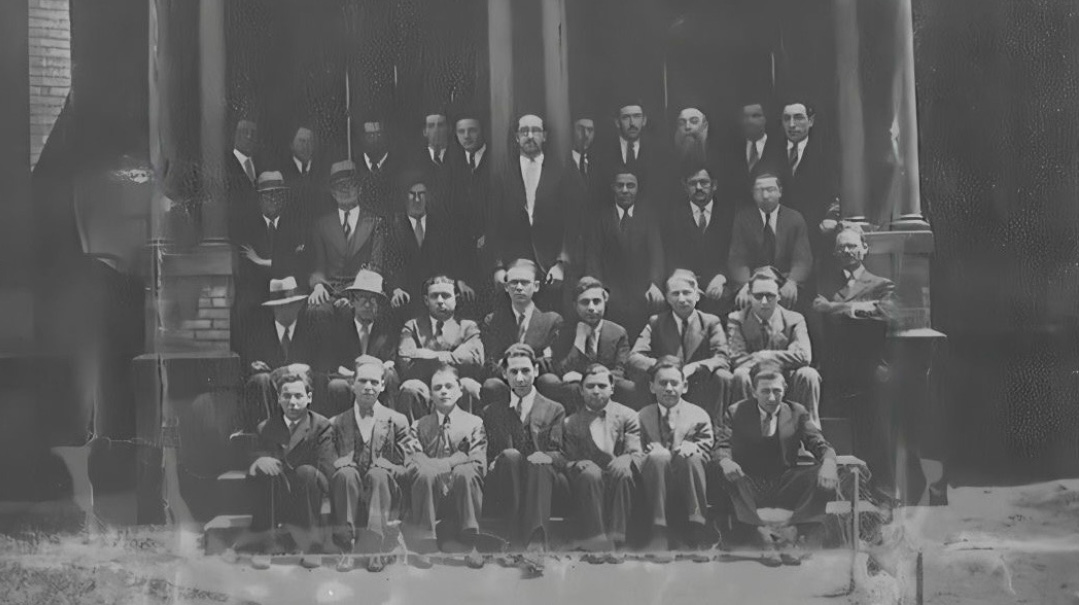
The yeshivah in the late 1920s. Rav Sheftel Kramer is in the top row, 3rd from right
In fact, 1929 was the year that “Slabodka in America” reached its apex. A writer from the Jewish Forum described the scene:
Cross the threshold of the New Haven Yeshivah, and you will find that you have leaped over the Atlantic and stepped right into the yeshivah of Slabodka. There is music in the air; aye, and what music! You could feel in it the very fire, the very bren of the Talmudic soul. The book-lined walls, the venerable Rav Sheftel (Kramer) pacing the floor up and down; the young students swaying over their big tomes of Talmud and issuing entrancing cries of “Oi, oi,” present a scene where Occidentalism is visibly being subjugated by Hebrew orientalism. Indeed, although the yeshivah is only a short distance away from Yale University, it is infinitely further removed from it than from Volozhin.
The present writer, however, was most impressed by the behavior of the talmidim and their superiors during a late Saturday afternoon between Minchah and evening services. The sun had sunk, and from the corners of the study hall, which also serves as the chapel, shadows emerged. The students were seated all about the room, some bending their heads over their breasts, as if mortally wounded; while others supported them with their hands, in dreamy fashion. There was dead silence. Night was slowly stealing into the Beth Hamidrash.
All of a sudden, one of the students began humming an air in a weeping tone and was joined by another in an opposite corner, who probably did not himself know that he was making use of his vocal cords. Presently a third scholar began impatiently pacing the hall, but before reaching the center of the room, a fourth approached him from an opposite side. Soon many more could be seen moving like shadows. The humming increased in volume, and tunes were heard from all sides and corners. They were passionate and full of religious fervor. It was twilight — an hour of hitorerut, of inspiration, of meditation, and introspection.
After observing the students for a considerable while, one cannot fail to understand why their program does not include secular studies. The content of molecules or the function of the pancreatic gland are facts all too cold to attract their attention. Their heart, their soul is entirely occupied by Akiba and Abaya, by Maimonides and Maharsha, and by the great Jewish moralist-psychologists, the Chachmei Hamussar.
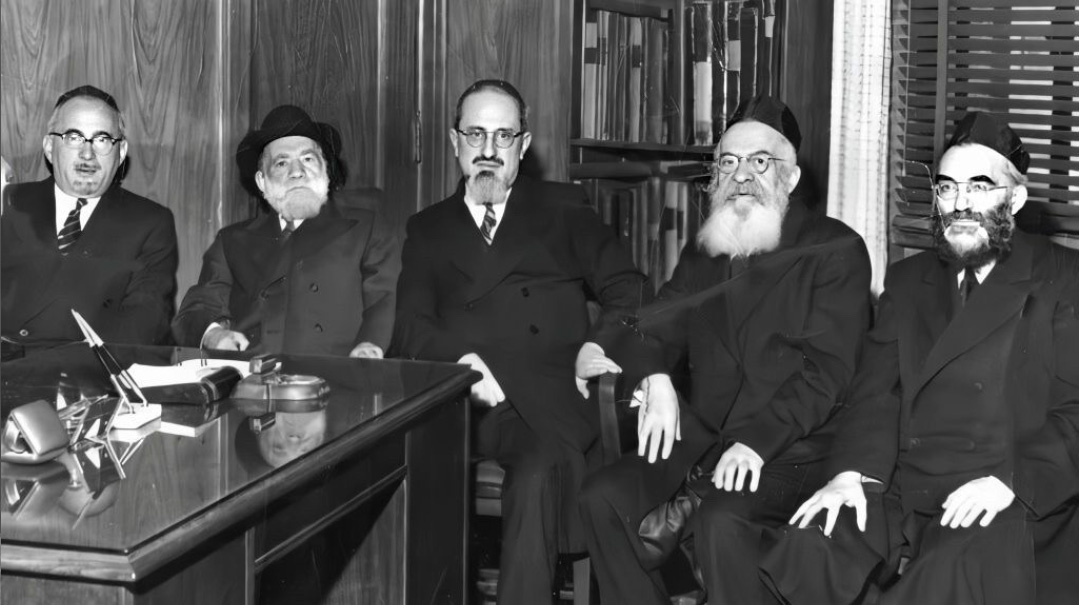
Rabbi Dr. Shmuel Belkin (left), along with other members of the RIETS semichah board, including Rav Chaim Heller (as a guest), Rav Joseph B. Soloveitchik, Rav Moshe Shatzkes (who was Rav Levenberg’s mechutan) and Rav Dovid Lifshitz (the Suvalker Rav)
Chapter 5
EMBATTLED WITHIN AND WITHOUT
Strife and Loss
The year 1929 would become a tipping point for Rav Levenberg in New Haven. He was not just the leader of a yeshivah, but also a community rabbi — and like many other leading American rabbinic figures of the time, he found himself embroiled in a bitter dispute over kashrus.
In a 1986 interview with Shoshana Kalter, a former New Haven student described the shul founded by Rav Levenberg’s small group of opponents in town: “Some people in the town didn’t like Rav Levenberg. So they started a new shul and (around town) they called it the Baal Shivikeh shul, because it was the ‘Bolsheviks’ that started it up.”
The dissent grew so bitter and so strong that the Agudath Harabonim dispatched a delegation to New Haven. Its members held an all-night session in the Orchard Street Shul, which ended in a victory for Rav Levenberg over his detractors.
But there was little time to celebrate the victory. Toward the end of August, word reached New Haven of the atrocities that had occurred in Chevron.
In a horrific pogrom on Shabbos morning, parshas Eikev (August 24), 67 Jews were slaughtered, and close to a hundred others injured and brutally maimed. Twenty-four of the martyrs were students of the Slabodka Yeshivah, which had opened a branch there in 1924.
This news was especially distressing for the New Haven Yeshivah, because Rav Moshe Mordechai Epstein’s second trip to America in 1927 had resulted in the recruitment to Chevron of several star New Haven students — including Nachum Dovid Herman, Boruch Kaplan, Aaron David Shainberg, and Zev Wolf Greenberg. Initial reports of the massacre were murky but stated that among the eight American students slain in Chevron were Kaplan, Shainberg, and Greenberg. Shortly thereafter, the US Embassy provided a correction, stating that Boruch Kaplan had miraculously survived.
Rav Levenberg spent the next week visiting the shivah homes of those American students who were killed, as well as speaking at various memorial events and demonstrations in support of the embattled Jews of the Yishuv.
That same month, Rav Levenberg was part of a delegation dispatched to resolve a conflict regarding kashrus in Cleveland, Ohio. The community was so impressed with his personality that he was offered the rabbinate of Cleveland’s Chibas Yerushalayim Shul, a shul founded by Lithuanian immigrants in 1904 and housed in a magnificent structure erected in 1926. The salary was said to be a generous $5,000 annually, though the most important part of the offer was that the shul building would be made available to house the New Haven Yeshivah, which would be transferred to Cleveland.
Train Ride to Cleveland
Rav Levenberg agreed to consider the offer. Cleveland’s Jewish community was approximately four times larger than that of New Haven, more prosperous, and seemed very eager to avail itself of a rav of his ilk.
(In the course of researching this article, several enthusiasts of Cleveland’s history have suggested to me that the prosperity observed by Rav Levenberg during his visit might have been influenced by the “Big Jewish Navy.” This term refers to a Jewish organized crime syndicate, which operated a fleet of boats on Lake Erie, smuggling liquor from Canada into the United States during the height of the Prohibition Era. This contraband was allegedly distributed nationwide in collaboration with infamous mobsters like Meyer Lansky. It’s important to note, however, that there is zero evidence linking these gangsters to the support of the yeshivah. To the contrary, the links between organized crime and beef/poultry racketeering would mean that they were likely among those who contributed to the harassment that Rav Levenberg was subjected to from those industries.)
Rav Levenberg spent the Yamim Noraim of 1929 in Cleveland, successfully raising $18,000 for a “Yeshivah Fund.” The Jews of New Haven, however, were very dismayed at the prospect of their yeshivah departing town. The intense pressure they exerted on the Levenbergs likely contributed to Rebbetzin Levenberg’s health issues, which became more pronounced in the fall of 1929, requiring hospitalization and complicating the move.
Dr. Ira Robinson quotes a letter written by Rav Levenberg to Abraham A. Katz, a local Cleveland activist, who was among the driving forces behind the yeshivah’s move. He wrote: “Upon reaching home, I found the Rebbetzin seriously ill, and her condition at present shows little improvement… I find this condition uppermost in my mind at present.”
Despite the challenges, on Wednesday, December 11, 1929, the New Haven Yeshivah officially moved to Cleveland. Large crowds met the train, which arrived nearly two hours late at 11 p.m. on the snowy evening. A grand kabbalas panim was held at the Chibas Yerushalayim Shul for Rav Levenberg and the 60 students who accompanied him.
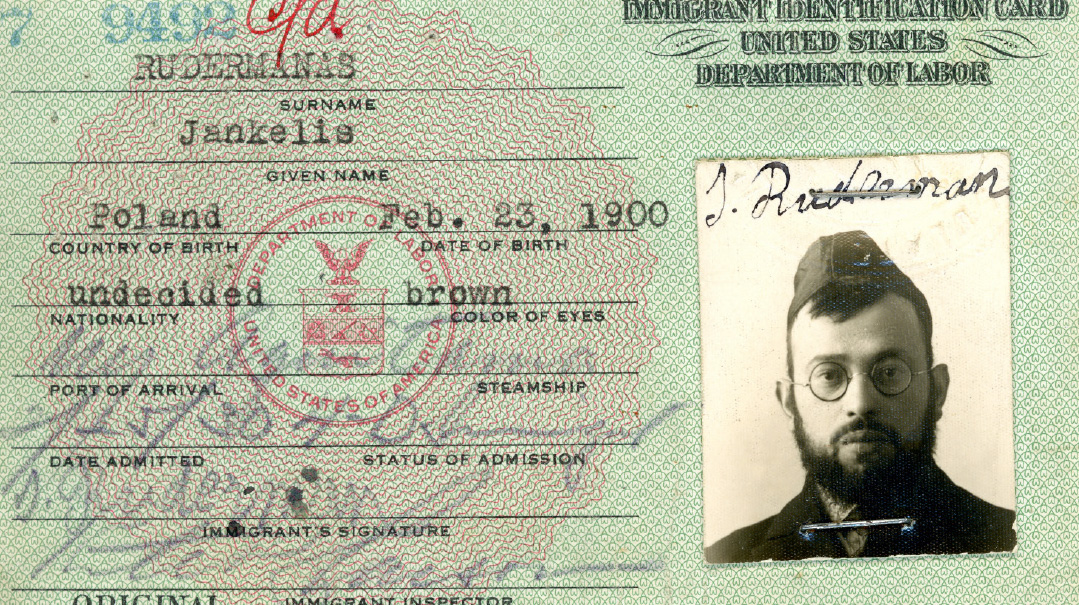
Rav Ruderman joined the yeshivah fresh off the boat from the Kovno kollel. His wife and daughter joined him 18 months later
New Talent
On January 6, 1930, Rav Levenberg penned a letter to Rav Eliezer Silver, expressing his hope that the new rav who’d assumed his former position in New Haven would resurrect and maintain a yeshivah there as well. He also informed Rav Silver that he had hired a 20-year-old musmach of Mir and Radin named Shmuel Belkin (1911-1976) to serve on the faculty.
Shmuel Belkin had arrived in Canada in January of 1929 and initially stayed with a sister near Windsor. With the assistance of Rabbi Nochum Shulman (1906-2006) (later of Minneapolis), he secured a student visa to the United States, where he was reunited with Rav Shimon Shkop (1860-1939), who was then delivering the top shiur at RIETS. Rav Shimon knew the young man they called “The Sislovicher Illui” (the same title given, decades earlier, to a young Rav Aharon Kotler, who hailed from the same town) and was glad to have a student of such high caliber studying with him.
Several months later, Rav Shimon decided to return to his yeshivah in Grodno. During the short gap between the time Rav Shimon departed and the arrival of his successor, Rav Moshe Soloveitchik (1879-1941), Rabbi Belkin delivered the shiur.
As Rav Levenberg was moving the yeshivah to Cleveland, he also dreamed of doubling or tripling its size, and so he sought to expand the staff with talented new rebbeim. It is likely that Rabbi Belkin was recommended at this juncture by Rav Shimon Shkop. (In a condolence letter written in 1938 to his student Shmuel Levenberg following his father’s passing, Rav Shimon referred to Rav Levenberg as: “the renowned gaon, repository of yiras Shamayim, from the remnants called upon by the Almighty, who dedicated all of his entire heart and soul to the fortifying of Torah…”)
In February 1930, Rav Levenberg further expanded the yeshivah’s faculty, inviting Rav Yaakov Yitzchok Ruderman, by then a brilliant member of the Slabodka kollel and the author of Sefer Avodas Levi, to join the Cleveland faculty. The students were excited to finally meet Rav Ruderman after hearing his father-in-law, Rav Sheftel Kramer, extoll his virtues countless times.
Rav Ruderman arrived on the same ship as the Dvar Avraham, who had written a letter enthusiastically applauding Rav Ruderman’s hiring, stating, “Fortunate are both you and the yeshivah, for you have wisely chosen a good and worthy [candidate], as [Rav Ruderman] is famous and well known for his mighty command of Shas Bavli and Yerushalmi, Rishonim and Acharonim; he descends to the depths of the sea of Talmud with his exceptional understanding, and ascends with precious pearls [of wisdom]…”
Rav Sheftel saw the arrival of Rav Ruderman as an important step forward for the yeshivah, and there was much excitement among the students when he officially joined the staff on March 12, 1930, two weeks after arriving in America.
However, Rav Kramer and Rav Ruderman did not see eye to eye with the academically inclined Rabbi Belkin, who left after just five months. (It seems that even after Rabbi Belkin’s departure, Rav Levenberg maintained a relationship with him, writing a hearty letter of recommendation for him to Professor Charles Torrey (1863-1956) at Yale University. Torrey was willing to accept Belkin at Yale’s Graduate School, but then advised him to choose a smaller institution and helped him gain acceptance to Brown University. In 1931, Rabbi Belkin departed New Haven for good, a journey which eventually would land him at Yeshiva University, where he succeeded Rabbi Dr. Bernard Revel as President in 1943.)
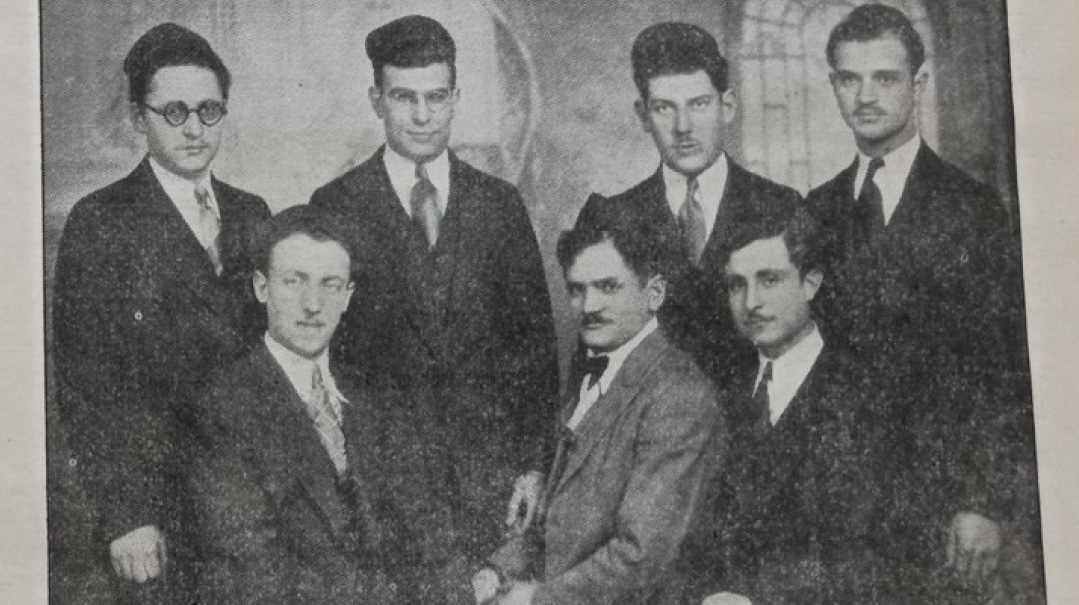
The yeshivah in Cleveland held a festive celebration in honor of seven new semichah recipients, March 1931
Keeping the Yeshivah Afloat
The yeshivah and its 60-plus students got off to a strong start in Cleveland, but prior to Pesach of that year, Rav Levenberg returned to New Haven tending to his ailing wife, and the yeshivah began to suffer from a leadership void.
The unlucky timing of Rav Levenberg’s wife’s illness coinciding with the sharp economic downturn that became the Great Depression, left the yeshivah without its founder and most energetic fundraiser at a most critical juncture. When Rav Levenberg did not return to Cleveland for the new zeman, both Rav Sheftel and Rav Ruderman were compelled to take on larger roles in the yeshivah’s administrative and financial governance.
Following Succos, Rav Kramer noted in a letter to Rav Levenberg that he had not received his salary in more than three weeks, and Rav Ruderman had gone even longer without pay. Stuck in New Haven with a local population that was less than thrilled to support a yeshivah no longer in their midst, Rav Levenberg struggled to raise the necessary funds.
The yeshivah was assisted by its sisterhood, which held fundraising events every month, but the winds of the Great Depression, combined with an overall ambivalence toward the concept of an “old-fashioned” yeshivah, drove it to the brink. One day, students arrived at their rented apartments to find their belongings on the curb — they had been evicted after the yeshivah failed to pay rent.
Murmurings about the issues the yeshivah was facing reached New York, and during the last week of June, Tageblatt editor Gedaliah Bublick (1875-1945) traveled to Cleveland to investigate for himself. On June 30th, he authored an extensive piece entitled “The Orphaned Yeshivah,” in which he questioned whether the yeshivah could survive without Rav Levenberg in a city that didn’t seem to appreciate it in the first place:
Sometimes it is the case that an institution can withstand the loss of a leading personality if it is in a supportive environment. But Cleveland is certainly not conducive for such a yeshivah. A city that does not have even one (Jewish) parochial school, and where Orthodoxy is lacking leadership, a city where the Orthodox powers are riven and divided, is certainly not the soil upon which such a yeshivah can grow. Especially as the yeshivah was not established by the Cleveland community, and the yeshivah was “thrust” upon the community.
The higher Torah institutions in America are in a difficult crisis. The New York Yeshivas Rabbeinu Yitzchak Elchanan and Chicago’s Bais Medrash L’Torah are in need [of aid], but the two institutions stand on firm ground. They are surrounded by a base of people that are devoted to them [the yeshivos], while the mussar yeshivah is in a strange place and stands alone. It makes an impression of a broken ship that gets tossed around in the wind without direction.
Left with no other choice, Rav Ruderman began to travel the United States to raise funds. He traveled to Chicago and then to Detroit, where he was assisted by Zvi Stollman (1911-1987), a New Haven student, who was the cousin of Rav Yitzchok Stollman (1897-1980), an influential Detroit rabbi who had attended Slabodka together with Rav Ruderman. In February of 1932, he headed to Baltimore (a city with which his name would yet be closely tied), and in June he traveled to Boston.
Along with those travels to distant locales, the yeshivah invested in outreach to the local Cleveland community as well: A weekly Friday night lecture series by yeshivah students was initiated during the winter of 1931, and Rav Sheftel and Rav Ruderman gave weekly derashos for the public at large during Shabbos morning davening.
On March 8, 1931, a grand chag hasemichah was held in Cleveland for seven students, partially in the hopes of raising funds. Rav Levenberg was able to travel to Cleveland for the ceremony, but could not remain. Rabbi Belkin, who had since rejoined RIETS, wrote to Rav Levenberg on behalf of Rav Revel, offering him a position giving a weekly mussar shmuess at the yeshivah. Rav Levenberg declined, though the reason was unclear. Some speculated it was because he was considering opening a new yeshivah in New Haven at the time.
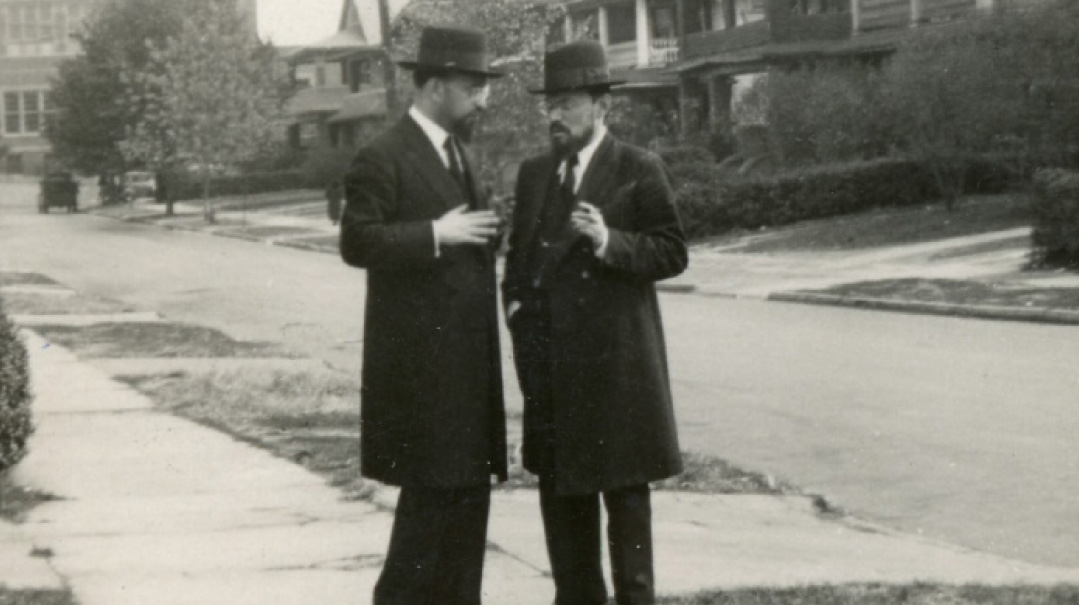
A rare photo of Reb Ruderman (left), taken soon after his arrival in Cleveland
The Rabbi and the Meat Wars
When Rav Levenberg finally returned to Cleveland (this time with his wife) in August of 1932, after a prolonged absence of more than two years, he found that Rav Sheftel and Rav Ruderman, who had valiantly kept the yeshivah afloat in his absence, had developed in the interim somewhat of an independent vision for the yeshivah, and found it challenging to merge those ideas with the direction of the now-present Rav Levenberg. The students, too, began to divide into two different camps.
Even as he faced this difficulty within his yeshivah, another local controversy loomed large. Rav Levenberg was officially installed as chief rabbi of Cleveland on December 4, 1932. But his relentless pursuit of authentic kashrus standards earned him the enmity of local shochtim and butchers — a phenomenon that was sadly common in American Jewish communities of the era.
As early as January 1930, Rav Levenberg unsuccessfully tried to obtain a court order that would prohibit slaughterhouses from marketing their meat as kosher unless they employed supervision from the Vaad Hakashrus. The court ruled, however, that the Vaad could not assert this authority over the Cleveland kosher meat industry.
Upon his return to the city in 1932, those tensions flared again. Rav Levenberg attempted to unite the Cleveland Orthodox rabbinate and lay leadership in a joint Vaad Hakehillos that would work to tackle the issue together. But not all the local rabbanim agreed to participate, and the two-cent tax levied to fund local kashrus supervision became difficult to enforce.
In December 1932, Rabbi Levenberg’s new organization called for a criminal investigation of all kosher butcher shops in Cleveland for alleged price-fixing and other improprieties. This unleashed a wave of protest and actual violence from some of the butchers, including incidents of broken shop windows, stink bombs, and an explosion that ripped a hole in a poultry market wall.
On the basis of false testimony from a poultry slaughterer and his wife, police warrants were issued by prosecutors for Rav Levenberg and two other men, accusing them of threatening the life of the shochet.
Rav Levenberg was arrested early one Friday morning and held in police custody all day before being released. The next Sunday, a massive crowd comprising an estimated 2,500 people protested the rabbi’s arrest. The local police chief, as well as Cleveland’s mayor, offered an apology, but this did not end Rav Levenberg’s troubles.
In April 1933, the window of his home was shattered by a brick, which a JTA report stated was “wrapped in a circular on one side of which was printed: ‘This is only a warning. Steps will follow.’ ”
Sadly, this issue was not resolved during Rav Levenberg’s lifetime, as the battles over kashrus in Cleveland raged well into the 1940s.
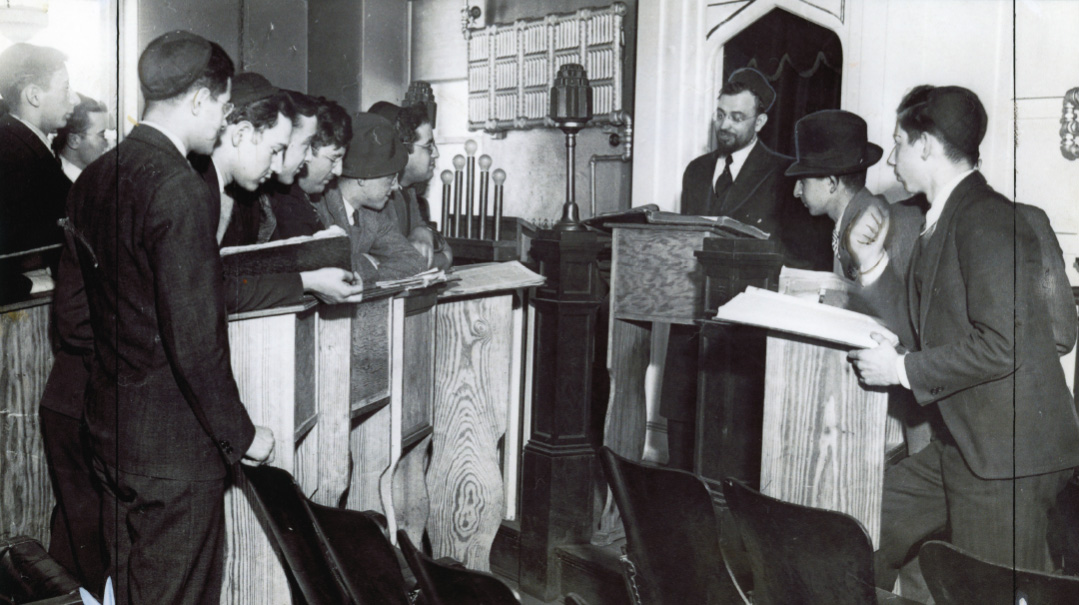
Rav Ruderman saying shiur during the early days of Ner Yisroel
Blow after Blow
At the same time, there was the tension within his own yeshivah to navigate. Rav Eliezer Silver, who had closely followed the arc of the yeshivah’s progress from its very inception in Lakewood in 1923, telegraphed on March 20 his intention of visiting the city to resolve the yeshivah’s conflicts.
By late April, Rav Silver had issued his verdict: The yeshivah was to be run jointly by all three faculty members — Rav Kramer would serve in an administrative role (responsible for all executive decisions), Rav Ruderman would function as the rosh yeshivah (and would have sole authority to admit prospective students), and Rav Levenberg would act as the menahel ruchani (with the role of inspiring the talmidim, either individually or in groups).
But the arrangement did not hold very long. In the summer or autumn of 1933, Rav Ruderman left for Baltimore. In October, he founded Ner Israel Rabbinical College, with four students from Cleveland. (The yeshivah was named for mussar founder Rav Yisroel Salanter.) Rav Sheftel Kramer stayed in Cleveland, where he served as a rav and delivered shiurim until his passing while visiting Baltimore in 1942.
Rav Levenberg was determined to find a suitable rosh yeshivah to replace Rav Ruderman, and once again, it was Rav Eliezer Silver who stepped in at a critical juncture to support the yeshivah, by recommending a candidate he had known for decades: Rav Uri Meir Tzirlin (1880-1954).
Rav Tzirlin was a native of Dusetos, Lithuania, where Rav Bunim Zemach Silver (father of Rav Eliezer) was the rav, and, like the younger Rav Silver, had studied in Dvinsk under Rav Meir Simcha and the Rogachover.
In February 1931, Rav Tzirlin traveled to the United States to help raise funds for the Kovno Kollel, spending the next several years traveling throughout North America, from Rochester, New York, to Denver, Colorado, and from Winnipeg, Manitoba to Los Angeles, California.
In January of 1934, Rav Tzirlin began saying shiurim at the yeshivah in Cleveland.
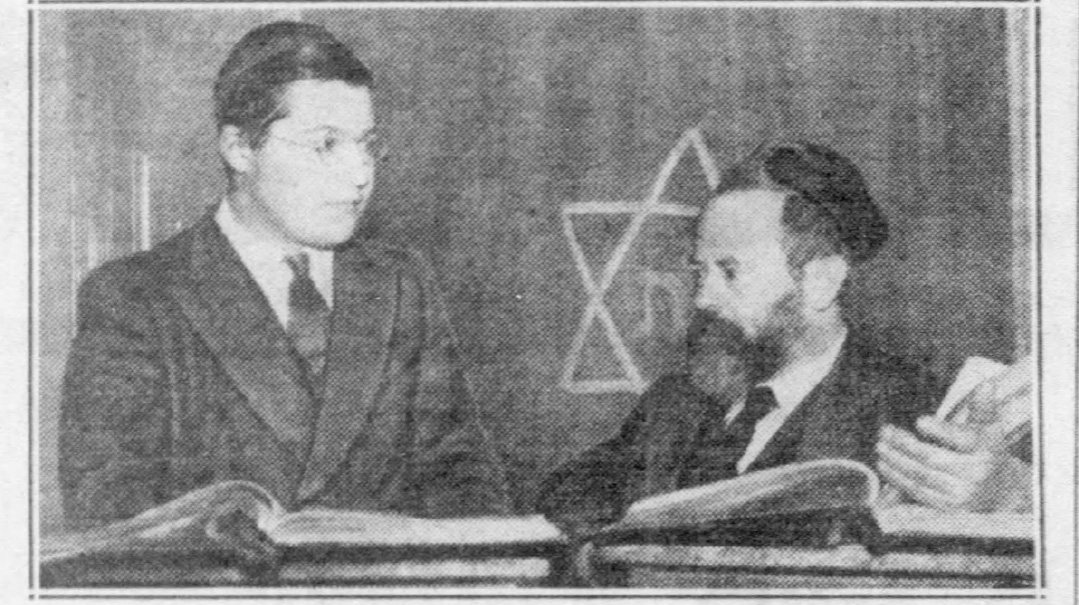
At first, the yeshivah continued to attract students. One headline-grabbing incident occurred when Cleveland police descended on the yeshivah on the evening of Wednesday, December 26, 1934. It seems that a 15-year-old student from the Lower East Side, named Abraham Orbach (1919-1962), had traveled to Cleveland several weeks earlier without his parents’ consent (his fellow classmates at Yeshiva Tifereth Jersualem had helped fund the trip), prompting the irate father to call the authorities. After several hours at the police station, Orbach was released back into the custody of the yeshivah after he categorically refused to return to New York.
The Yeshiva also announced, in May of 1936, the purchase of 880 Lakeview Road, the property they had until now been leasing.
But then registration began to dwindle. And the yeshivah received another blow when Rav Tzirlin’s poor health necessitated his move west, to the warmer climate of Los Angeles (he continued to be active in spreading Torah, taking the helm of Yeshivas HaMa’arav, also known as the Pacific Hebrew Seminary).
Rav Levenberg made one final attempt to inject vitality into the yeshivah, with the hiring of two new faculty members. One was a fellow Slabodka alum and rabbi of Canton, Ohio, named Rav Chaim Elazary (1902-1984). The other was a 42-year-old rav, posek, and scholar who had arrived in the United States from Russia several months earlier; his name was Rav Moshe Feinstein (1895-1986).
In conjunction with the pair’s arrival, plans were announced for a preparatory Talmud Torah division, which would provide Jewish education every afternoon from 3:30 to 7:30. A grand reception was planned for April 11th to welcome the two new roshei yeshivah, and hopefully to herald a robust new era for the beleaguered institution.
At the welcome reception, however, Rav Levenberg appeared noticeably ill, and his address that evening was markedly subdued, lacking his usual trademark passion. Word began to spread: Rav Levenberg had been diagnosed with a brain tumor.
He traveled to Mt. Sinai Hospital in New York City for treatment and stayed there for several months, far from his students and his life’s passion. The yeshivah, already in a shaky state beforehand, was now in a precarious position.
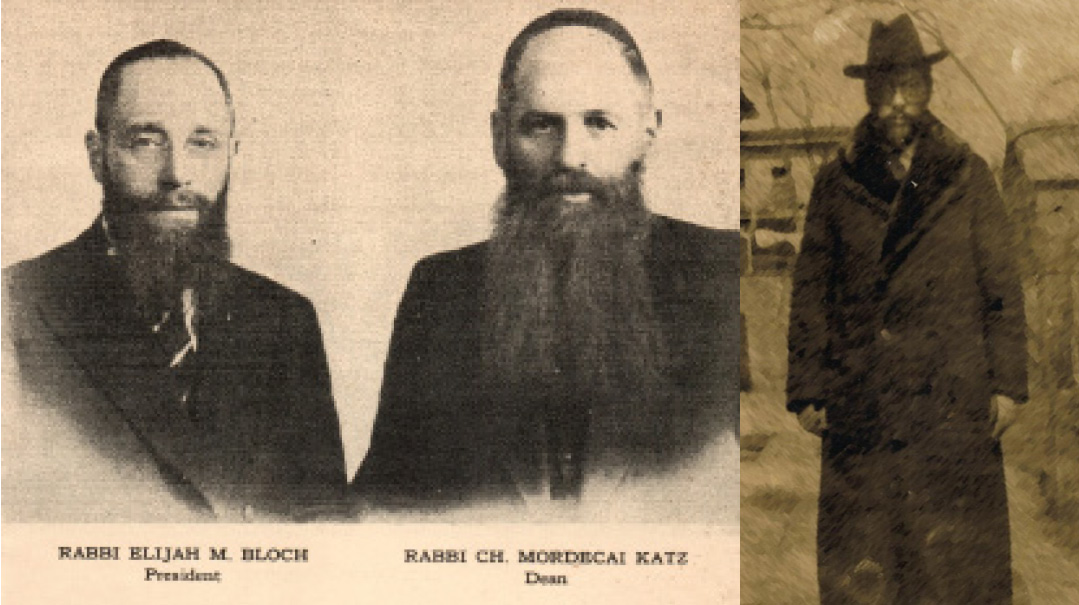
The flame of the Telshe yeshivah which had been extinguished in Lithuania was rekindled in Cleveland. Rav Nochum Zev Dessler (1921-2011) recalled how nearly a thousand people gathered into the Chibas Yerushalayim shul, which had once housed the New Haven Yeshivah, to welcome the Telshe roshei yeshivah upon their arrival in 1941
Keep the Lamp Lit
In a letter to Ezras Torah’s Rav Yisrael Rosenberg written on June 1st, Rav Moshe Feinstein confided that “regrettably… I have not yet found my place here, and it does not appear that there will exist here in the future an appropriate and steady position for me, according to the situation that I found here….”
It was a prescient analysis. In the autumn of 1937, Rav Levenberg’s friends and former students (led by the Gordon family of Jamaica and Rav Boruch Kaplan), arranged for him to move to Williamsburg in Brooklyn. A campaign was launched to raise $3,000, so an apartment on Keap Street (a few blocks over from the Penn Street residence of his eldest daughter Brocha Mintz), could be leased for him and his family.
They also “hired” Rav Levenberg (for $50 a week) to hold small, intimate mussar talks in his home for his circle of followers — a role that gave him significant invigoration. (During this period, he was tended to devotedly by Mrs. Esther Soloff ((1894–1945)), who lived two blocks over on Ross Street.) When he was feeling well enough to go out for davening, he would frequent the famous Polisher Shtibel, around the corner on Division Avenue.
On Chanukah, these New Haven alumni joined for a gathering at Rav Levenberg’s apartment. In addition to Rav Levenberg himself, the crowd was also addressed by some of his students, such as Rav Moshe Gordon, Rav Nachum David Herman, and Rav Shmuel Schechter.
By then, the yeshivah was no more: several weeks earlier, Young Israel of Cleveland announced the acquisition of “the former Yeshivah building at 880 Lakeview Road.” (It was a fitting succession, as Rav Levenberg had long been a supporter of the Young Israel movement, and he played an active role in the establishment of the Young Israel chapter in New Haven.)
Fewer than three weeks before his passing, Rav Levenberg traveled back to Cleveland, for what would be his final visit. The occasion was a farewell tribute held by local friends and supporters, in what was now the Young Israel of Cleveland.
When it was Rav Levenberg’s turn to speak, he urged all those present to continue their efforts to carry on and spread the study of Talmud and all Jewish literature. He then proceeded to gift the entire seforim library of the yeshivah to the Young Israel, almost as if to emphasize his point about keeping the study of Torah alive in Cleveland.
And indeed, as Rav Elya Meir Bloch (1894-1955) once commented to Rav Yisrael Shurin (1918-2007), the reason Cleveland was selected in 1941 as the site to reconstruct the refugee Telshe Yeshiva, was because the lamp lit by Rav Levenberg had not yet been extinguished.
During his final illness, Rav Levenberg was often cared for by Reb Shmuel Schechter, who would even sleep in his apartment to ensure all his needs were met. Many decades later, Reb Shmuel recounted the events of the fateful Shabbos parshas Beshalach, the 13th of Shevat (January 15th, 1938):
And I remember that in the morning, I got up in the morning on Shabbos — I was meshamesh him, I slept there and I… because he needed it, and it was a big zechus — so I remember I went over to him and I asked him how he’s feeling, and I asked him whether I should remain in the house or I should go to shul.
So he says: “Go to shul, no question about it,” he’s feeling well enough, I should go to shul.
And in the middle of the davening; so someone came running and told me, “Rav Levenberg wants to see you right away, right away!” And I understood, already, that it was an emergency, so I ran, and I came in — it must have been a minute after yetzias neshamah….
He was 54 years old.
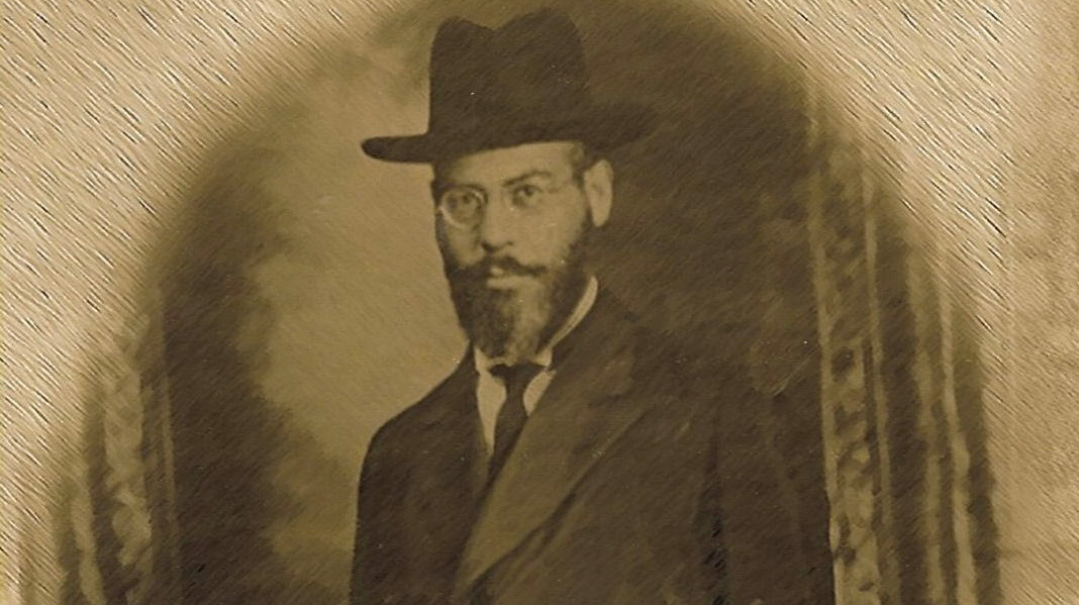
Utterly Simple
The levayah was scheduled to begin at 1 p.m. on Sunday afternoon, but a crowd of mourners — it would eventually approach an estimated 10,000 — among them prominent rabbanim from New York City and many of Rav Levenberg’s students, started assembling long before the appointed time.
From the humble apartment on Keap Street, the aron was carried by the talmidim, first to the nearby Polisher Shtibel, and then around the corner to Wilson Street, to Torah Vodaath — an institution that was the quiet beneficiary of Rav Levenberg’s vision and pioneering spirit.
Tearful hespedim were delivered, first by rabbanim such as Rav Yehuda Leib Seltzer of the Agudath Harabonim, Rav Avraham Yitzchak Zelmanovits (1887-1946) of Yeshivas Rabbeinu Yitzchak Elchanan (and the unofficial rav of the Polisher Shtibel), Rav Yitzchak Bunin (1872-1982), a prominent Williamsburg Rav, and a 29-year-old rav named Rav Pinchas Teitz (1908-1995) from Elizabeth, New Jersey (who, like Rav Levenberg, was a Latvian-born Slabodka graduate), and others. They were followed by several students, including Rav Eliyahu Moshe Gordon and Rav Nachum Dovid Herman.
The aron was then transported to New Haven for burial, where another levayah, of unprecedented size in New Haven’s history, was held on Monday, Tu B’Shevat. After stopping at the Rose Street Shul, the procession continued to the Beth Israel Shul on Orchard Street, where Rav Levenberg was eulogized, first by some of the New Haven rabbanim, including Rav Ahron Schuchatowitz (1901-1974) and Rav Eliezer Gorelick (1896-1979) (among others), followed by fellow Connecticut rabbanim including Rav Ephraim Pelcovitz (1885-1965) of Bridgeport, and Rav Levenberg’s longtime partner, Rav Moshe Don Sheinkopf of Waterbury.
Some of the maspidim of the previous day in Williamsburg, like Rav Bunin, Rav Teitz, and Rav Gordon spoke again in New Haven. They were joined by Rav Tzemach Zambrowsky of Cleveland, who had served as the yeshivah’s administrator during its last years.
A particularly emotional hesped was given by Rav Levenberg’s son Shmuel, who had recently returned from studying in Grodno and Mir and would serve as a rav in New Haven in the years that followed.
During his earlier, serious illness in New Haven in 1924, Rabbi Levenberg had written his will, which delineated specific instructions to be followed at his death:
It was after a critical night that I took stock of body and soul. I feared terribly that my faith would be shaken and that I would be unable to accept my fate with equanimity. But this night has almost yielded to the dawn and at five a.m. I write this testament in full consciousness of my instructions.
Firstly. I wish it to be made known that I forgive all who may have caused me grief or insult, or who spoke evil against me. I would ask of my children forgiveness for my having failed to give them the fullest attention they deserved.
My place of burial shall be in New Haven and the monument of my grave shall be utterly simple and on it shall be merely inscribed: Here rests Yehuda Heschel ben Zvi HaLevi Levenberg who served as rabbi in New Haven. No titles shall be included, merely the brief indication that I did my work with sincerity in spreading knowledge of the Torah through the Yeshiva in this community.
Rabbi Levenberg’s wish was honored. The exact text he requested for his matzeivah can be seen at New Haven’s Beth Israel Cemetery.
A beautiful obituary appeared in the rabbinic journal HaPardes, drawing comparisons between Rav Levenberg’s tenure in the United States and Moshe Rabbeinu on the shores of the Yam Suf (Rav Levenberg passed away on the morning of Shabbos parshas Beshalach, making the parallel all the more timely). Amid all the masses scrambling for material wealth, both these leaders cared only for spiritual concerns.
Rav Yehuda Heschel Levenberg, declared HaPardes, resembled the biblical Yehuda: sent to a new, strange land, ahead of everybody else, to build a yeshivah for the future arrivals.
In a sense, the story of Rav Levenberg’s New Haven Yeshivah is a melancholy tale: the story of a dream realized only for a tantalizingly short while, a vision that was snatched away before it could be fully actualized.
Rav Yitzchak Hutner, however, had a different perspective. In remarks delivered on the occasion of Rav Levenberg’s first yahrtzeit, Rav Hutner drew a comparison between Rav Levenberg and Dovid Hamelech.
While Dovid did not actually live to realize his dream of constructing the Beis Hamikdash, Chazal emphasize that it was nevertheless referred to as his Mikdash — Mizmor shir chanukas habayis l’Dovid — on account of his selfless devotion for the cause.
Rav Levenberg, too, declared Rav Hutner, passed away before he could witness the genuine renaissance of Torah in the United States. But his unflagging struggle to achieve that mission marks him as a founding father of America’s Torah world.
The comprehensive works and vast knowledge of the following individuals were consulted in preparation for this article:
Rabbi Yitzchok Tzvi Ever, Dr. Ira Robinson, Mrs. Devora Gliksman, Rabbi Yosef Karmen, Rav Shmuel Schechter, Rav Shachne Zohn, Shulamith Berger, Feivel Schneider, Yehuda Geberer, Chaya Sarah Herman, Yale University Judaica Collection, Dr. David S. Fisher, Professor William Helmreich, Zalman Alpert, Rabbi Dr. Ari Z. Zivotofsky, Professor Shaul Stampfer, Professor Marc Shapiro, Yoeli Hirsch, Machon Avodas Levi, Shraga Homnick, Yaakov Neuberger, Eli Neuberger, Morris Deutsch, Bernard Maza
(Originally featured in Mishpacha, Issue 1008)
Oops! We could not locate your form.







